Financial Accounting: Reconciliation, Control Accounts and Variances
VerifiedAdded on 2023/01/12
|21
|4301
|64
Report
AI Summary
This financial accounting report provides a detailed exploration of key concepts and methods. It begins with an introduction to financial accounting, emphasizing its role in preparing financial statements for internal and external stakeholders. The report then delves into double-entry bookkeeping, trial balances, and relevant accounting regulations. It differentiates between financial reports and financial statements and explains the accounts for sole traders, partnerships, and limited companies, highlighting their differences. The report also covers the reconciliation process, tools, and techniques used for checking general ledger accounts, as well as the importance of correctly entered figures and variances. Control accounts, suspense accounts, and their uses in financial accounting are explained, along with the processes for reconciling these accounts. Several case studies are included to illustrate the application of these concepts. The report concludes with an overview of financial accounting principles, including the preparation of final accounts, bank reconciliation statements, and control accounts.
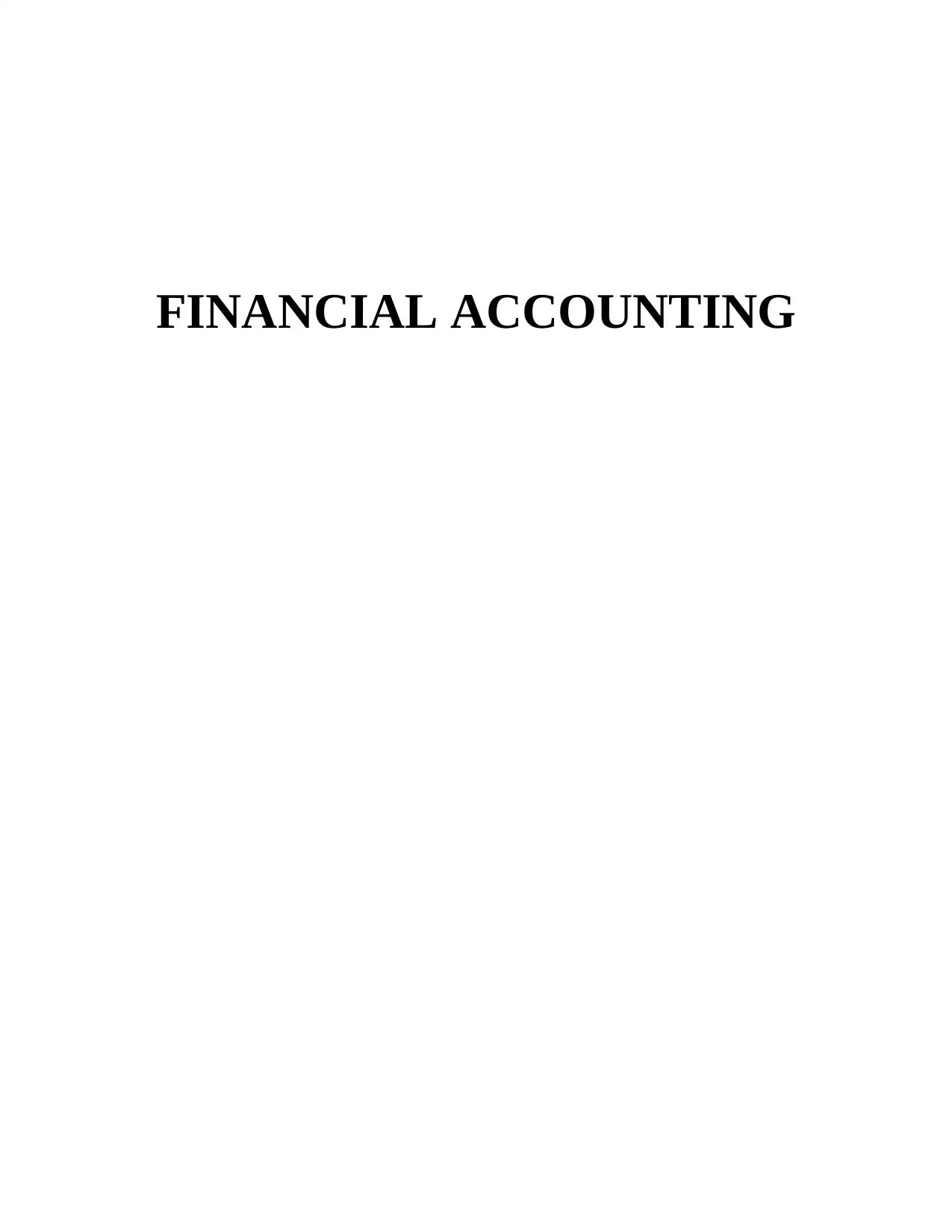
FINANCIAL ACCOUNTING
Paraphrase This Document
Need a fresh take? Get an instant paraphrase of this document with our AI Paraphraser
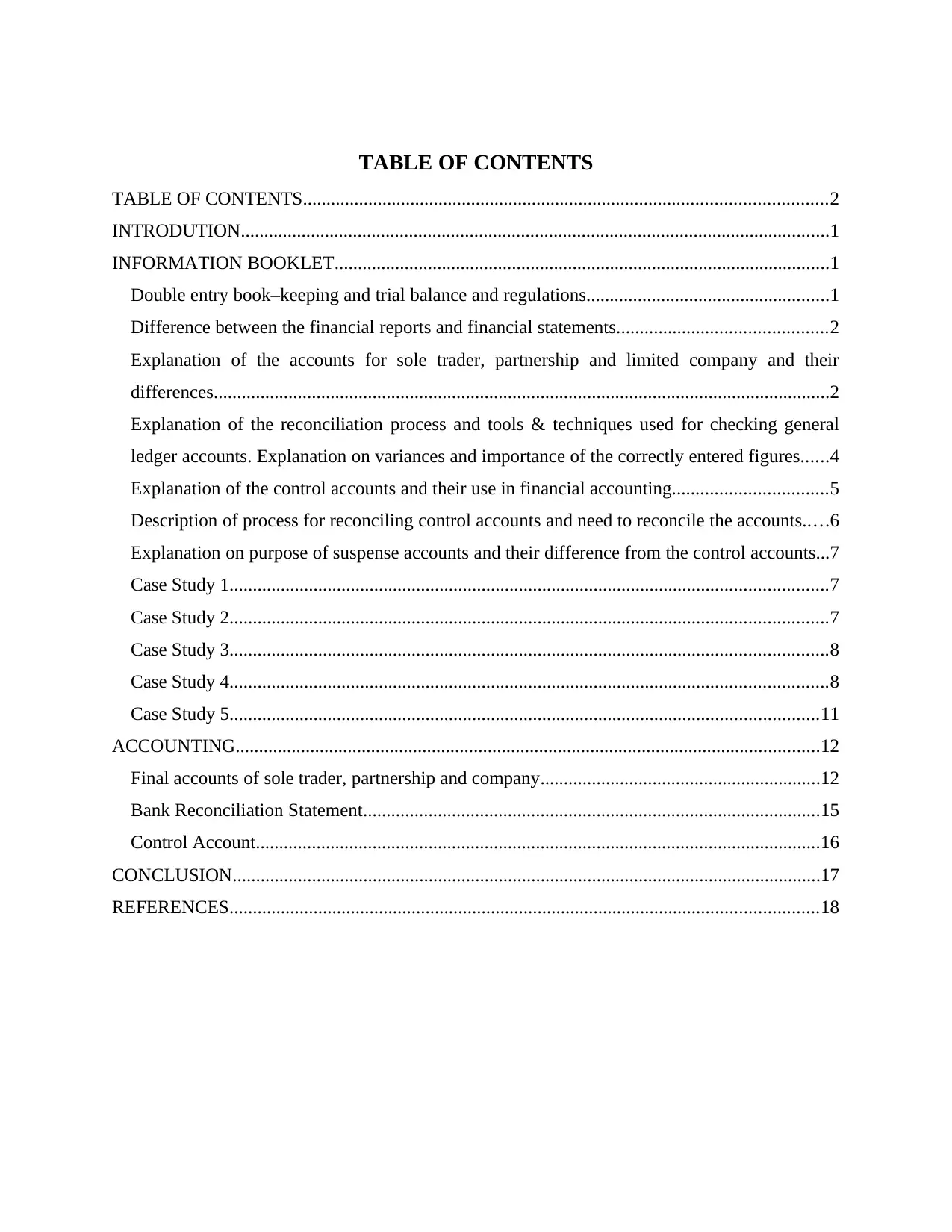
TABLE OF CONTENTS
TABLE OF CONTENTS................................................................................................................2
INTRODUTION..............................................................................................................................1
INFORMATION BOOKLET..........................................................................................................1
Double entry book–keeping and trial balance and regulations....................................................1
Difference between the financial reports and financial statements.............................................2
Explanation of the accounts for sole trader, partnership and limited company and their
differences....................................................................................................................................2
Explanation of the reconciliation process and tools & techniques used for checking general
ledger accounts. Explanation on variances and importance of the correctly entered figures......4
Explanation of the control accounts and their use in financial accounting.................................5
Description of process for reconciling control accounts and need to reconcile the accounts.....6
Explanation on purpose of suspense accounts and their difference from the control accounts...7
Case Study 1................................................................................................................................7
Case Study 2................................................................................................................................7
Case Study 3................................................................................................................................8
Case Study 4................................................................................................................................8
Case Study 5..............................................................................................................................11
ACCOUNTING.............................................................................................................................12
Final accounts of sole trader, partnership and company............................................................12
Bank Reconciliation Statement..................................................................................................15
Control Account.........................................................................................................................16
CONCLUSION..............................................................................................................................17
REFERENCES..............................................................................................................................18
TABLE OF CONTENTS................................................................................................................2
INTRODUTION..............................................................................................................................1
INFORMATION BOOKLET..........................................................................................................1
Double entry book–keeping and trial balance and regulations....................................................1
Difference between the financial reports and financial statements.............................................2
Explanation of the accounts for sole trader, partnership and limited company and their
differences....................................................................................................................................2
Explanation of the reconciliation process and tools & techniques used for checking general
ledger accounts. Explanation on variances and importance of the correctly entered figures......4
Explanation of the control accounts and their use in financial accounting.................................5
Description of process for reconciling control accounts and need to reconcile the accounts.....6
Explanation on purpose of suspense accounts and their difference from the control accounts...7
Case Study 1................................................................................................................................7
Case Study 2................................................................................................................................7
Case Study 3................................................................................................................................8
Case Study 4................................................................................................................................8
Case Study 5..............................................................................................................................11
ACCOUNTING.............................................................................................................................12
Final accounts of sole trader, partnership and company............................................................12
Bank Reconciliation Statement..................................................................................................15
Control Account.........................................................................................................................16
CONCLUSION..............................................................................................................................17
REFERENCES..............................................................................................................................18

INTRODUTION
Financial accounting refers to process of preparing the financial statements which represents
the financial position and performance of the company. These financial information is useful for
both the internal management and stakeholders of the company such as creditors, investors,
suppliers and customers. Financial accounting is different from managerial accounting that
prepares financial records for the internal management of the company. Financial statements
prepared by the company are income statement, balance sheet and cash flow statements. They
are prepared by the company as per the applicable accounting standards. Present report will be
revealing about the concepts and methods of financial accounting. It will provide explanation on
double entry book keeping, financial reports and the financial statements. It will also provide
about the sole traders, partnership and limited company form of doing business. Report will
address the reconciliation process and techniques used for checking the balances of general
ledger and the use of control accounts in financial accounting. The concepts will be explained
with the help of examples and case studies. Study will enhance the understanding of financial
accounting concepts and techniques.
INFORMATION BOOKLET
Double entry book–keeping and trial balance and regulations.
Book keeping or double entry system
means that every transaction of the business
affects minimum two accounts. It is to be
recorded in at least two accounts.. It was
established for giving equal effects to the
debit and credit side of the balances. Double
entry requires the accounting equation to be
in balance i.e. assets = owner’s equity +
liabilities. This requires the balance in assets
side should be equal to the balance in
liabilities and equity side.
Trial balance is statement prepared in
double entry system containing the debits
and credit balances of all the ledger
accounts. Trial balance is prepared after
closing the ledger accounts for balancing the
debits and credit side of all the accounts of
business. Trial balance is prepared by the
business for ensuring that entries recorded
for the financial transactions in the ledger
accounts and are balanced at the end. The
debit and credit side of the trial balance
should be equal. In a double entry system
trial balance is used for the preparation of
financial statements. Balance of the accounts
in trial balance is transferred to the
respective financial statements which are
income statement and balance sheet
1
Financial accounting refers to process of preparing the financial statements which represents
the financial position and performance of the company. These financial information is useful for
both the internal management and stakeholders of the company such as creditors, investors,
suppliers and customers. Financial accounting is different from managerial accounting that
prepares financial records for the internal management of the company. Financial statements
prepared by the company are income statement, balance sheet and cash flow statements. They
are prepared by the company as per the applicable accounting standards. Present report will be
revealing about the concepts and methods of financial accounting. It will provide explanation on
double entry book keeping, financial reports and the financial statements. It will also provide
about the sole traders, partnership and limited company form of doing business. Report will
address the reconciliation process and techniques used for checking the balances of general
ledger and the use of control accounts in financial accounting. The concepts will be explained
with the help of examples and case studies. Study will enhance the understanding of financial
accounting concepts and techniques.
INFORMATION BOOKLET
Double entry book–keeping and trial balance and regulations.
Book keeping or double entry system
means that every transaction of the business
affects minimum two accounts. It is to be
recorded in at least two accounts.. It was
established for giving equal effects to the
debit and credit side of the balances. Double
entry requires the accounting equation to be
in balance i.e. assets = owner’s equity +
liabilities. This requires the balance in assets
side should be equal to the balance in
liabilities and equity side.
Trial balance is statement prepared in
double entry system containing the debits
and credit balances of all the ledger
accounts. Trial balance is prepared after
closing the ledger accounts for balancing the
debits and credit side of all the accounts of
business. Trial balance is prepared by the
business for ensuring that entries recorded
for the financial transactions in the ledger
accounts and are balanced at the end. The
debit and credit side of the trial balance
should be equal. In a double entry system
trial balance is used for the preparation of
financial statements. Balance of the accounts
in trial balance is transferred to the
respective financial statements which are
income statement and balance sheet
1
You're viewing a preview
Unlock full access by subscribing today!
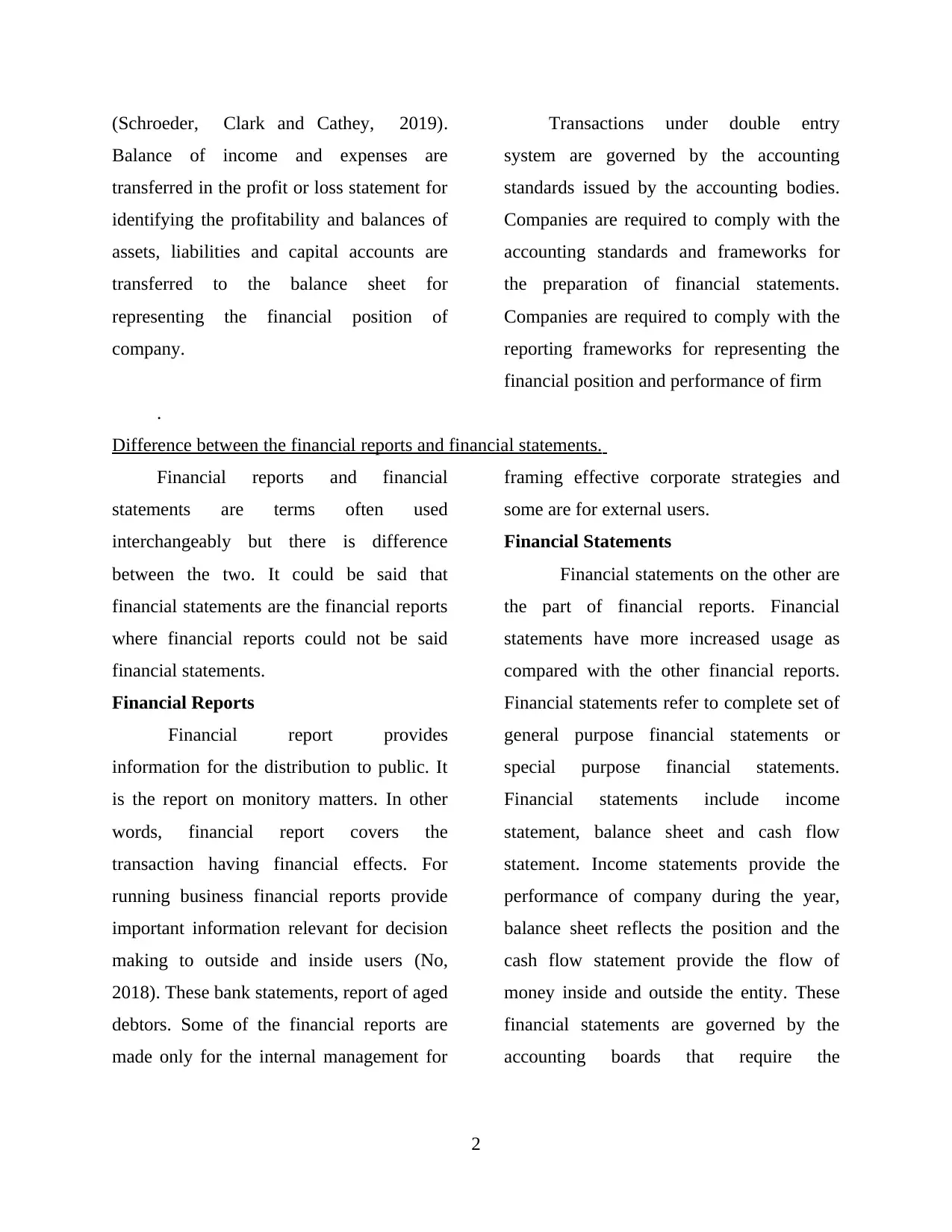
(Schroeder, Clark and Cathey, 2019).
Balance of income and expenses are
transferred in the profit or loss statement for
identifying the profitability and balances of
assets, liabilities and capital accounts are
transferred to the balance sheet for
representing the financial position of
company.
Transactions under double entry
system are governed by the accounting
standards issued by the accounting bodies.
Companies are required to comply with the
accounting standards and frameworks for
the preparation of financial statements.
Companies are required to comply with the
reporting frameworks for representing the
financial position and performance of firm
.
Difference between the financial reports and financial statements.
Financial reports and financial
statements are terms often used
interchangeably but there is difference
between the two. It could be said that
financial statements are the financial reports
where financial reports could not be said
financial statements.
Financial Reports
Financial report provides
information for the distribution to public. It
is the report on monitory matters. In other
words, financial report covers the
transaction having financial effects. For
running business financial reports provide
important information relevant for decision
making to outside and inside users (No,
2018). These bank statements, report of aged
debtors. Some of the financial reports are
made only for the internal management for
framing effective corporate strategies and
some are for external users.
Financial Statements
Financial statements on the other are
the part of financial reports. Financial
statements have more increased usage as
compared with the other financial reports.
Financial statements refer to complete set of
general purpose financial statements or
special purpose financial statements.
Financial statements include income
statement, balance sheet and cash flow
statement. Income statements provide the
performance of company during the year,
balance sheet reflects the position and the
cash flow statement provide the flow of
money inside and outside the entity. These
financial statements are governed by the
accounting boards that require the
2
Balance of income and expenses are
transferred in the profit or loss statement for
identifying the profitability and balances of
assets, liabilities and capital accounts are
transferred to the balance sheet for
representing the financial position of
company.
Transactions under double entry
system are governed by the accounting
standards issued by the accounting bodies.
Companies are required to comply with the
accounting standards and frameworks for
the preparation of financial statements.
Companies are required to comply with the
reporting frameworks for representing the
financial position and performance of firm
.
Difference between the financial reports and financial statements.
Financial reports and financial
statements are terms often used
interchangeably but there is difference
between the two. It could be said that
financial statements are the financial reports
where financial reports could not be said
financial statements.
Financial Reports
Financial report provides
information for the distribution to public. It
is the report on monitory matters. In other
words, financial report covers the
transaction having financial effects. For
running business financial reports provide
important information relevant for decision
making to outside and inside users (No,
2018). These bank statements, report of aged
debtors. Some of the financial reports are
made only for the internal management for
framing effective corporate strategies and
some are for external users.
Financial Statements
Financial statements on the other are
the part of financial reports. Financial
statements have more increased usage as
compared with the other financial reports.
Financial statements refer to complete set of
general purpose financial statements or
special purpose financial statements.
Financial statements include income
statement, balance sheet and cash flow
statement. Income statements provide the
performance of company during the year,
balance sheet reflects the position and the
cash flow statement provide the flow of
money inside and outside the entity. These
financial statements are governed by the
accounting boards that require the
2
Paraphrase This Document
Need a fresh take? Get an instant paraphrase of this document with our AI Paraphraser
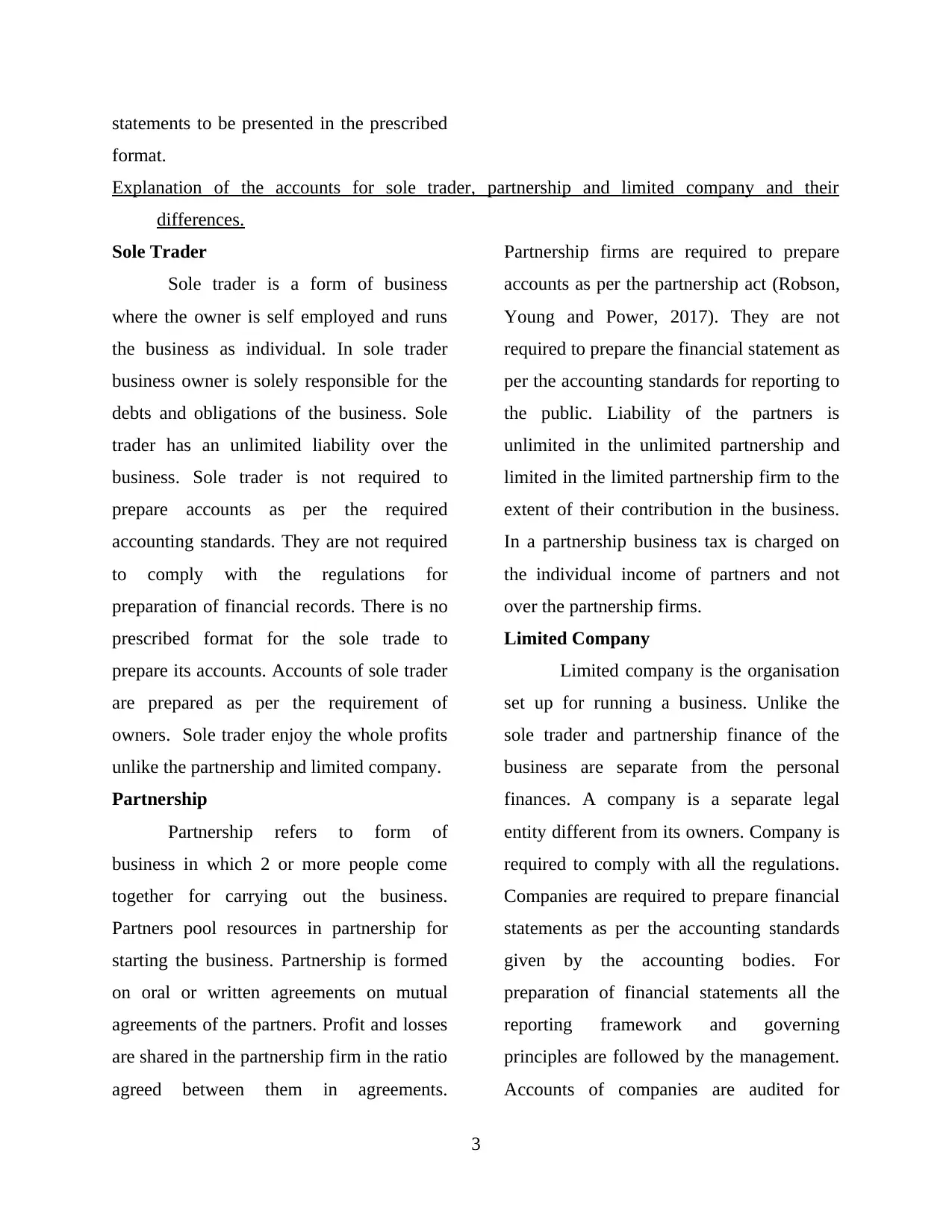
statements to be presented in the prescribed
format.
Explanation of the accounts for sole trader, partnership and limited company and their
differences.
Sole Trader
Sole trader is a form of business
where the owner is self employed and runs
the business as individual. In sole trader
business owner is solely responsible for the
debts and obligations of the business. Sole
trader has an unlimited liability over the
business. Sole trader is not required to
prepare accounts as per the required
accounting standards. They are not required
to comply with the regulations for
preparation of financial records. There is no
prescribed format for the sole trade to
prepare its accounts. Accounts of sole trader
are prepared as per the requirement of
owners. Sole trader enjoy the whole profits
unlike the partnership and limited company.
Partnership
Partnership refers to form of
business in which 2 or more people come
together for carrying out the business.
Partners pool resources in partnership for
starting the business. Partnership is formed
on oral or written agreements on mutual
agreements of the partners. Profit and losses
are shared in the partnership firm in the ratio
agreed between them in agreements.
Partnership firms are required to prepare
accounts as per the partnership act (Robson,
Young and Power, 2017). They are not
required to prepare the financial statement as
per the accounting standards for reporting to
the public. Liability of the partners is
unlimited in the unlimited partnership and
limited in the limited partnership firm to the
extent of their contribution in the business.
In a partnership business tax is charged on
the individual income of partners and not
over the partnership firms.
Limited Company
Limited company is the organisation
set up for running a business. Unlike the
sole trader and partnership finance of the
business are separate from the personal
finances. A company is a separate legal
entity different from its owners. Company is
required to comply with all the regulations.
Companies are required to prepare financial
statements as per the accounting standards
given by the accounting bodies. For
preparation of financial statements all the
reporting framework and governing
principles are followed by the management.
Accounts of companies are audited for
3
format.
Explanation of the accounts for sole trader, partnership and limited company and their
differences.
Sole Trader
Sole trader is a form of business
where the owner is self employed and runs
the business as individual. In sole trader
business owner is solely responsible for the
debts and obligations of the business. Sole
trader has an unlimited liability over the
business. Sole trader is not required to
prepare accounts as per the required
accounting standards. They are not required
to comply with the regulations for
preparation of financial records. There is no
prescribed format for the sole trade to
prepare its accounts. Accounts of sole trader
are prepared as per the requirement of
owners. Sole trader enjoy the whole profits
unlike the partnership and limited company.
Partnership
Partnership refers to form of
business in which 2 or more people come
together for carrying out the business.
Partners pool resources in partnership for
starting the business. Partnership is formed
on oral or written agreements on mutual
agreements of the partners. Profit and losses
are shared in the partnership firm in the ratio
agreed between them in agreements.
Partnership firms are required to prepare
accounts as per the partnership act (Robson,
Young and Power, 2017). They are not
required to prepare the financial statement as
per the accounting standards for reporting to
the public. Liability of the partners is
unlimited in the unlimited partnership and
limited in the limited partnership firm to the
extent of their contribution in the business.
In a partnership business tax is charged on
the individual income of partners and not
over the partnership firms.
Limited Company
Limited company is the organisation
set up for running a business. Unlike the
sole trader and partnership finance of the
business are separate from the personal
finances. A company is a separate legal
entity different from its owners. Company is
required to comply with all the regulations.
Companies are required to prepare financial
statements as per the accounting standards
given by the accounting bodies. For
preparation of financial statements all the
reporting framework and governing
principles are followed by the management.
Accounts of companies are audited for
3

ensuring that statements are free from errors
and misstatements before they are issued to
the public. Liabilities of company do not
extend to personal assets of owners. Also the
corporation tax is charged over the profits of
company and not like sole trader and
partnership business.
Explanation of the reconciliation process and tools & techniques used for checking general
ledger accounts. Explanation on variances and importance of the correctly entered figures.
Reconciliation is described as
the process of matching the accounts
that are recorded against the monthly
statements from the external sources
like bank statements for identifying
the differences in records. It other
words it is the process which
compares 2 sets of records for
identifying that the recorded figures
are in agreement and correct (Pratt,
2016). Accounts reconciliation is also
performed for ensuring that balances
in the general ledger are accurate,
consistent and complete. Company is
required to analyse the records of
general ledgers to ensure that they ar
correctly recorded and are free from
material misstatements.
Reconciliation process includes
reconciling the accounts of ledger with the
bank statement for ensuring that all the
entries are correctly recorded. There are
cases where the entries are recorded in cash
ledger of company but are not recorded in
the bank statement due to delay or errors. in
the bank reconciliation statement entries
recorded in the bank ledger and not in bank
statements are adjusted and vice versa. The
reconciliation process allows teh company
to identify the errors done on bank side and
identifying the frauds if any committed by
the employees of company. Trial balance is
also prepared for identifying that the balance
sin the ledger accounts are identified when
the balance of debit side is not equal to the
credit side.
Reconciliation should be performed on
regular basis for ensuring the integrity of the
financial records. It helps to uncover the
omission, theft, duplication and the
fraudulent transactions.
Document review is the method
involving review of the existing transactions
and documents for making sure that amount
recorded is actual amount spent. This review
is generally carried out with the help of
software (Narayanaswamy, 2017). For
example for reviewing the receipts and
identifying the discrepancies. It reconciles
the accounts with the actual invoices of the
4
and misstatements before they are issued to
the public. Liabilities of company do not
extend to personal assets of owners. Also the
corporation tax is charged over the profits of
company and not like sole trader and
partnership business.
Explanation of the reconciliation process and tools & techniques used for checking general
ledger accounts. Explanation on variances and importance of the correctly entered figures.
Reconciliation is described as
the process of matching the accounts
that are recorded against the monthly
statements from the external sources
like bank statements for identifying
the differences in records. It other
words it is the process which
compares 2 sets of records for
identifying that the recorded figures
are in agreement and correct (Pratt,
2016). Accounts reconciliation is also
performed for ensuring that balances
in the general ledger are accurate,
consistent and complete. Company is
required to analyse the records of
general ledgers to ensure that they ar
correctly recorded and are free from
material misstatements.
Reconciliation process includes
reconciling the accounts of ledger with the
bank statement for ensuring that all the
entries are correctly recorded. There are
cases where the entries are recorded in cash
ledger of company but are not recorded in
the bank statement due to delay or errors. in
the bank reconciliation statement entries
recorded in the bank ledger and not in bank
statements are adjusted and vice versa. The
reconciliation process allows teh company
to identify the errors done on bank side and
identifying the frauds if any committed by
the employees of company. Trial balance is
also prepared for identifying that the balance
sin the ledger accounts are identified when
the balance of debit side is not equal to the
credit side.
Reconciliation should be performed on
regular basis for ensuring the integrity of the
financial records. It helps to uncover the
omission, theft, duplication and the
fraudulent transactions.
Document review is the method
involving review of the existing transactions
and documents for making sure that amount
recorded is actual amount spent. This review
is generally carried out with the help of
software (Narayanaswamy, 2017). For
example for reviewing the receipts and
identifying the discrepancies. It reconciles
the accounts with the actual invoices of the
4
You're viewing a preview
Unlock full access by subscribing today!
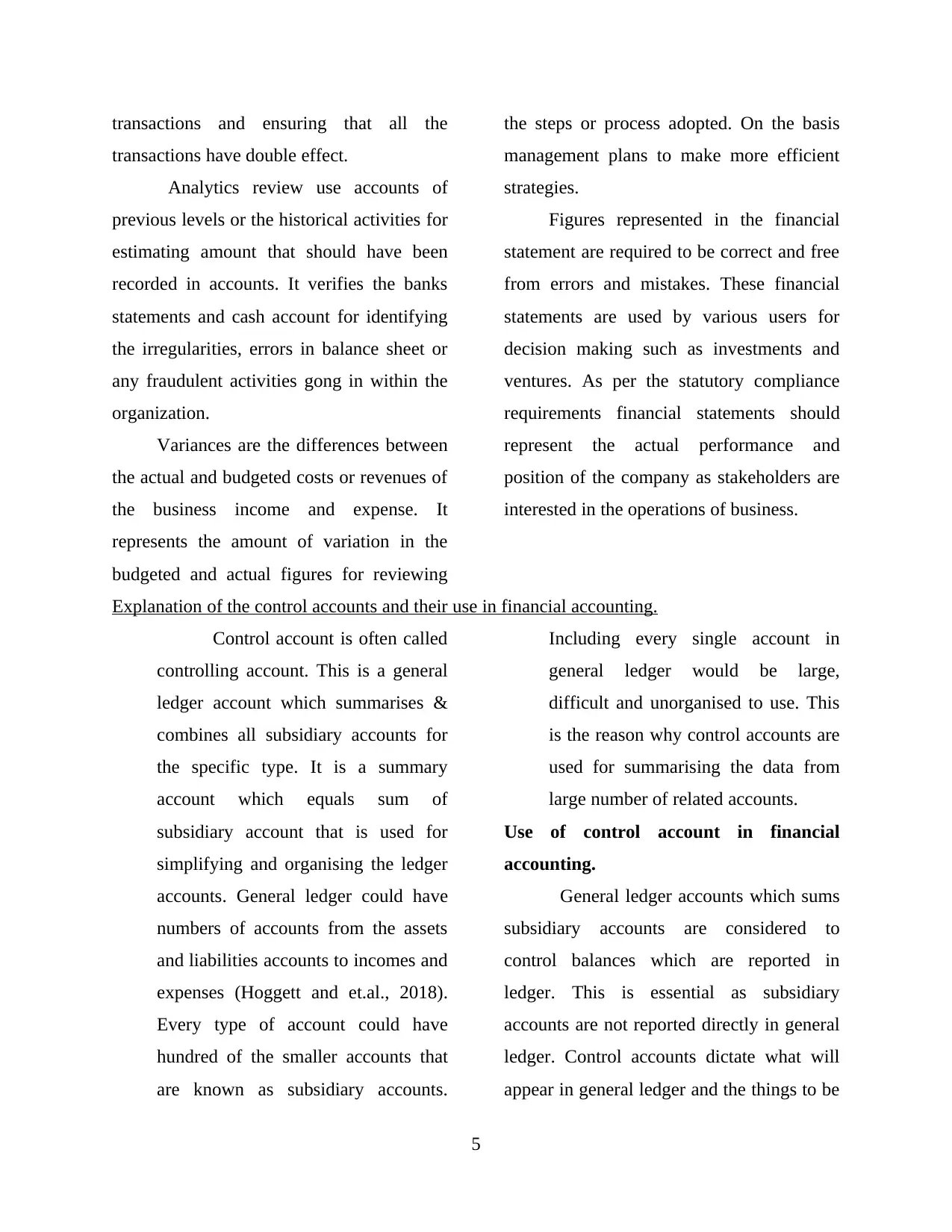
transactions and ensuring that all the
transactions have double effect.
Analytics review use accounts of
previous levels or the historical activities for
estimating amount that should have been
recorded in accounts. It verifies the banks
statements and cash account for identifying
the irregularities, errors in balance sheet or
any fraudulent activities gong in within the
organization.
Variances are the differences between
the actual and budgeted costs or revenues of
the business income and expense. It
represents the amount of variation in the
budgeted and actual figures for reviewing
the steps or process adopted. On the basis
management plans to make more efficient
strategies.
Figures represented in the financial
statement are required to be correct and free
from errors and mistakes. These financial
statements are used by various users for
decision making such as investments and
ventures. As per the statutory compliance
requirements financial statements should
represent the actual performance and
position of the company as stakeholders are
interested in the operations of business.
Explanation of the control accounts and their use in financial accounting.
Control account is often called
controlling account. This is a general
ledger account which summarises &
combines all subsidiary accounts for
the specific type. It is a summary
account which equals sum of
subsidiary account that is used for
simplifying and organising the ledger
accounts. General ledger could have
numbers of accounts from the assets
and liabilities accounts to incomes and
expenses (Hoggett and et.al., 2018).
Every type of account could have
hundred of the smaller accounts that
are known as subsidiary accounts.
Including every single account in
general ledger would be large,
difficult and unorganised to use. This
is the reason why control accounts are
used for summarising the data from
large number of related accounts.
Use of control account in financial
accounting.
General ledger accounts which sums
subsidiary accounts are considered to
control balances which are reported in
ledger. This is essential as subsidiary
accounts are not reported directly in general
ledger. Control accounts dictate what will
appear in general ledger and the things to be
5
transactions have double effect.
Analytics review use accounts of
previous levels or the historical activities for
estimating amount that should have been
recorded in accounts. It verifies the banks
statements and cash account for identifying
the irregularities, errors in balance sheet or
any fraudulent activities gong in within the
organization.
Variances are the differences between
the actual and budgeted costs or revenues of
the business income and expense. It
represents the amount of variation in the
budgeted and actual figures for reviewing
the steps or process adopted. On the basis
management plans to make more efficient
strategies.
Figures represented in the financial
statement are required to be correct and free
from errors and mistakes. These financial
statements are used by various users for
decision making such as investments and
ventures. As per the statutory compliance
requirements financial statements should
represent the actual performance and
position of the company as stakeholders are
interested in the operations of business.
Explanation of the control accounts and their use in financial accounting.
Control account is often called
controlling account. This is a general
ledger account which summarises &
combines all subsidiary accounts for
the specific type. It is a summary
account which equals sum of
subsidiary account that is used for
simplifying and organising the ledger
accounts. General ledger could have
numbers of accounts from the assets
and liabilities accounts to incomes and
expenses (Hoggett and et.al., 2018).
Every type of account could have
hundred of the smaller accounts that
are known as subsidiary accounts.
Including every single account in
general ledger would be large,
difficult and unorganised to use. This
is the reason why control accounts are
used for summarising the data from
large number of related accounts.
Use of control account in financial
accounting.
General ledger accounts which sums
subsidiary accounts are considered to
control balances which are reported in
ledger. This is essential as subsidiary
accounts are not reported directly in general
ledger. Control accounts dictate what will
appear in general ledger and the things to be
5
Paraphrase This Document
Need a fresh take? Get an instant paraphrase of this document with our AI Paraphraser
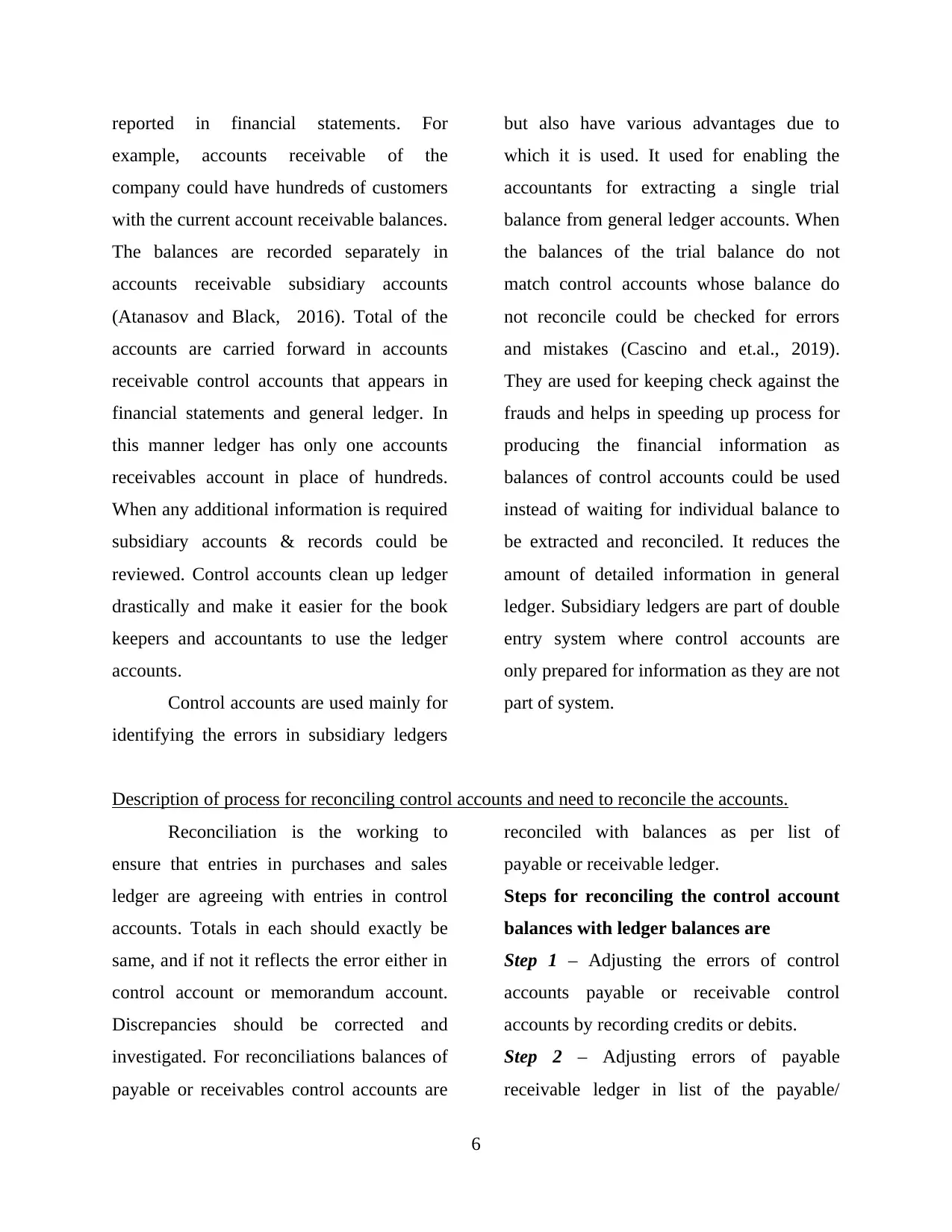
reported in financial statements. For
example, accounts receivable of the
company could have hundreds of customers
with the current account receivable balances.
The balances are recorded separately in
accounts receivable subsidiary accounts
(Atanasov and Black, 2016). Total of the
accounts are carried forward in accounts
receivable control accounts that appears in
financial statements and general ledger. In
this manner ledger has only one accounts
receivables account in place of hundreds.
When any additional information is required
subsidiary accounts & records could be
reviewed. Control accounts clean up ledger
drastically and make it easier for the book
keepers and accountants to use the ledger
accounts.
Control accounts are used mainly for
identifying the errors in subsidiary ledgers
but also have various advantages due to
which it is used. It used for enabling the
accountants for extracting a single trial
balance from general ledger accounts. When
the balances of the trial balance do not
match control accounts whose balance do
not reconcile could be checked for errors
and mistakes (Cascino and et.al., 2019).
They are used for keeping check against the
frauds and helps in speeding up process for
producing the financial information as
balances of control accounts could be used
instead of waiting for individual balance to
be extracted and reconciled. It reduces the
amount of detailed information in general
ledger. Subsidiary ledgers are part of double
entry system where control accounts are
only prepared for information as they are not
part of system.
Description of process for reconciling control accounts and need to reconcile the accounts.
Reconciliation is the working to
ensure that entries in purchases and sales
ledger are agreeing with entries in control
accounts. Totals in each should exactly be
same, and if not it reflects the error either in
control account or memorandum account.
Discrepancies should be corrected and
investigated. For reconciliations balances of
payable or receivables control accounts are
reconciled with balances as per list of
payable or receivable ledger.
Steps for reconciling the control account
balances with ledger balances are
Step 1 – Adjusting the errors of control
accounts payable or receivable control
accounts by recording credits or debits.
Step 2 – Adjusting errors of payable
receivable ledger in list of the payable/
6
example, accounts receivable of the
company could have hundreds of customers
with the current account receivable balances.
The balances are recorded separately in
accounts receivable subsidiary accounts
(Atanasov and Black, 2016). Total of the
accounts are carried forward in accounts
receivable control accounts that appears in
financial statements and general ledger. In
this manner ledger has only one accounts
receivables account in place of hundreds.
When any additional information is required
subsidiary accounts & records could be
reviewed. Control accounts clean up ledger
drastically and make it easier for the book
keepers and accountants to use the ledger
accounts.
Control accounts are used mainly for
identifying the errors in subsidiary ledgers
but also have various advantages due to
which it is used. It used for enabling the
accountants for extracting a single trial
balance from general ledger accounts. When
the balances of the trial balance do not
match control accounts whose balance do
not reconcile could be checked for errors
and mistakes (Cascino and et.al., 2019).
They are used for keeping check against the
frauds and helps in speeding up process for
producing the financial information as
balances of control accounts could be used
instead of waiting for individual balance to
be extracted and reconciled. It reduces the
amount of detailed information in general
ledger. Subsidiary ledgers are part of double
entry system where control accounts are
only prepared for information as they are not
part of system.
Description of process for reconciling control accounts and need to reconcile the accounts.
Reconciliation is the working to
ensure that entries in purchases and sales
ledger are agreeing with entries in control
accounts. Totals in each should exactly be
same, and if not it reflects the error either in
control account or memorandum account.
Discrepancies should be corrected and
investigated. For reconciliations balances of
payable or receivables control accounts are
reconciled with balances as per list of
payable or receivable ledger.
Steps for reconciling the control account
balances with ledger balances are
Step 1 – Adjusting the errors of control
accounts payable or receivable control
accounts by recording credits or debits.
Step 2 – Adjusting errors of payable
receivable ledger in list of the payable/
6
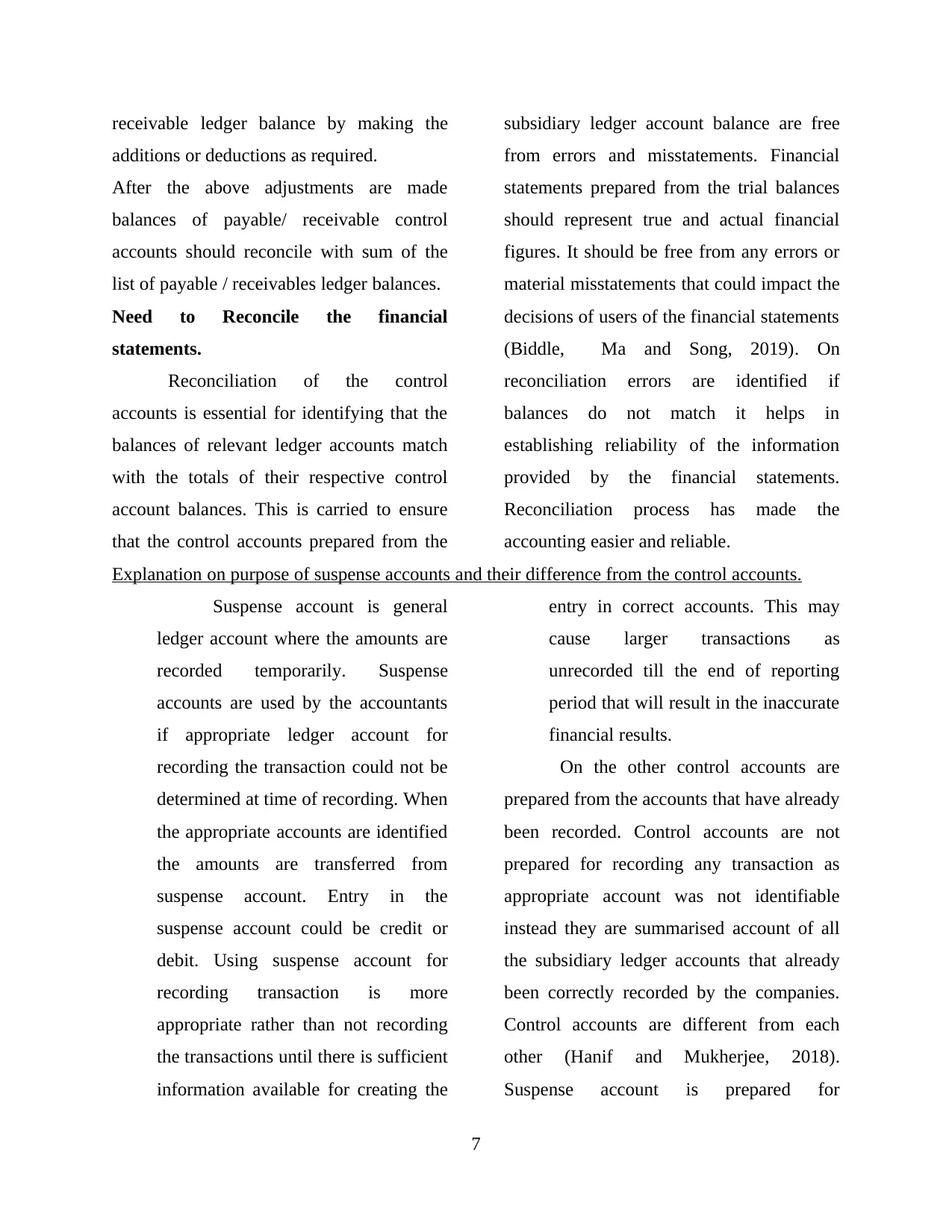
receivable ledger balance by making the
additions or deductions as required.
After the above adjustments are made
balances of payable/ receivable control
accounts should reconcile with sum of the
list of payable / receivables ledger balances.
Need to Reconcile the financial
statements.
Reconciliation of the control
accounts is essential for identifying that the
balances of relevant ledger accounts match
with the totals of their respective control
account balances. This is carried to ensure
that the control accounts prepared from the
subsidiary ledger account balance are free
from errors and misstatements. Financial
statements prepared from the trial balances
should represent true and actual financial
figures. It should be free from any errors or
material misstatements that could impact the
decisions of users of the financial statements
(Biddle, Ma and Song, 2019). On
reconciliation errors are identified if
balances do not match it helps in
establishing reliability of the information
provided by the financial statements.
Reconciliation process has made the
accounting easier and reliable.
Explanation on purpose of suspense accounts and their difference from the control accounts.
Suspense account is general
ledger account where the amounts are
recorded temporarily. Suspense
accounts are used by the accountants
if appropriate ledger account for
recording the transaction could not be
determined at time of recording. When
the appropriate accounts are identified
the amounts are transferred from
suspense account. Entry in the
suspense account could be credit or
debit. Using suspense account for
recording transaction is more
appropriate rather than not recording
the transactions until there is sufficient
information available for creating the
entry in correct accounts. This may
cause larger transactions as
unrecorded till the end of reporting
period that will result in the inaccurate
financial results.
On the other control accounts are
prepared from the accounts that have already
been recorded. Control accounts are not
prepared for recording any transaction as
appropriate account was not identifiable
instead they are summarised account of all
the subsidiary ledger accounts that already
been correctly recorded by the companies.
Control accounts are different from each
other (Hanif and Mukherjee, 2018).
Suspense account is prepared for
7
additions or deductions as required.
After the above adjustments are made
balances of payable/ receivable control
accounts should reconcile with sum of the
list of payable / receivables ledger balances.
Need to Reconcile the financial
statements.
Reconciliation of the control
accounts is essential for identifying that the
balances of relevant ledger accounts match
with the totals of their respective control
account balances. This is carried to ensure
that the control accounts prepared from the
subsidiary ledger account balance are free
from errors and misstatements. Financial
statements prepared from the trial balances
should represent true and actual financial
figures. It should be free from any errors or
material misstatements that could impact the
decisions of users of the financial statements
(Biddle, Ma and Song, 2019). On
reconciliation errors are identified if
balances do not match it helps in
establishing reliability of the information
provided by the financial statements.
Reconciliation process has made the
accounting easier and reliable.
Explanation on purpose of suspense accounts and their difference from the control accounts.
Suspense account is general
ledger account where the amounts are
recorded temporarily. Suspense
accounts are used by the accountants
if appropriate ledger account for
recording the transaction could not be
determined at time of recording. When
the appropriate accounts are identified
the amounts are transferred from
suspense account. Entry in the
suspense account could be credit or
debit. Using suspense account for
recording transaction is more
appropriate rather than not recording
the transactions until there is sufficient
information available for creating the
entry in correct accounts. This may
cause larger transactions as
unrecorded till the end of reporting
period that will result in the inaccurate
financial results.
On the other control accounts are
prepared from the accounts that have already
been recorded. Control accounts are not
prepared for recording any transaction as
appropriate account was not identifiable
instead they are summarised account of all
the subsidiary ledger accounts that already
been correctly recorded by the companies.
Control accounts are different from each
other (Hanif and Mukherjee, 2018).
Suspense account is prepared for
7
You're viewing a preview
Unlock full access by subscribing today!
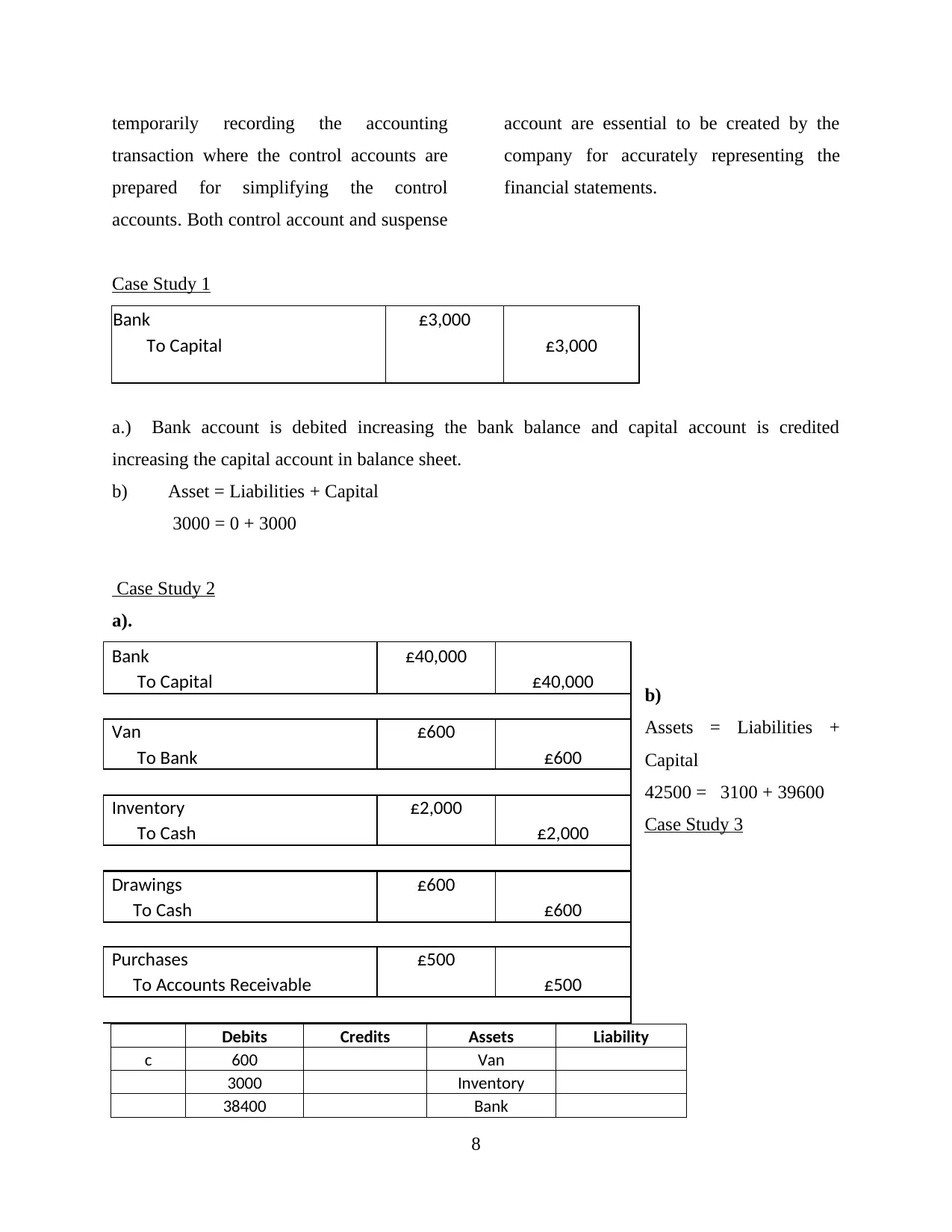
temporarily recording the accounting
transaction where the control accounts are
prepared for simplifying the control
accounts. Both control account and suspense
account are essential to be created by the
company for accurately representing the
financial statements.
Case Study 1
Bank £3,000
To Capital £3,000
a.) Bank account is debited increasing the bank balance and capital account is credited
increasing the capital account in balance sheet.
b) Asset = Liabilities + Capital
3000 = 0 + 3000
Case Study 2
a).
b)
Assets = Liabilities +
Capital
42500 = 3100 + 39600
Case Study 3
Debits Credits Assets Liability
c 600 Van
3000 Inventory
38400 Bank
8
Bank £40,000
To Capital £40,000
Van £600
To Bank £600
Inventory £2,000
To Cash £2,000
Drawings £600
To Cash £600
Purchases £500
To Accounts Receivable £500
transaction where the control accounts are
prepared for simplifying the control
accounts. Both control account and suspense
account are essential to be created by the
company for accurately representing the
financial statements.
Case Study 1
Bank £3,000
To Capital £3,000
a.) Bank account is debited increasing the bank balance and capital account is credited
increasing the capital account in balance sheet.
b) Asset = Liabilities + Capital
3000 = 0 + 3000
Case Study 2
a).
b)
Assets = Liabilities +
Capital
42500 = 3100 + 39600
Case Study 3
Debits Credits Assets Liability
c 600 Van
3000 Inventory
38400 Bank
8
Bank £40,000
To Capital £40,000
Van £600
To Bank £600
Inventory £2,000
To Cash £2,000
Drawings £600
To Cash £600
Purchases £500
To Accounts Receivable £500
Paraphrase This Document
Need a fresh take? Get an instant paraphrase of this document with our AI Paraphraser

d 40000 Assets
e 600 600 -600 -600
f 600 Van
3000 Inventory
39400 Capital
g 39400 0 Assets
Case Study 4
Task 1
Account Debit Credit
Bank £30,000
To Capital A/c £30,000
Van £600
To Bank £600
Purchases £2,000
To Bank £2,000
Drawings £60
To Bank £60
Purchases £700
To Cash £700
Cash £2,500
To Sales £2,500
Rent £400
To Cash £400
Total £36,260 £36,260
Task 2
Ledger accounts
9
e 600 600 -600 -600
f 600 Van
3000 Inventory
39400 Capital
g 39400 0 Assets
Case Study 4
Task 1
Account Debit Credit
Bank £30,000
To Capital A/c £30,000
Van £600
To Bank £600
Purchases £2,000
To Bank £2,000
Drawings £60
To Bank £60
Purchases £700
To Cash £700
Cash £2,500
To Sales £2,500
Rent £400
To Cash £400
Total £36,260 £36,260
Task 2
Ledger accounts
9
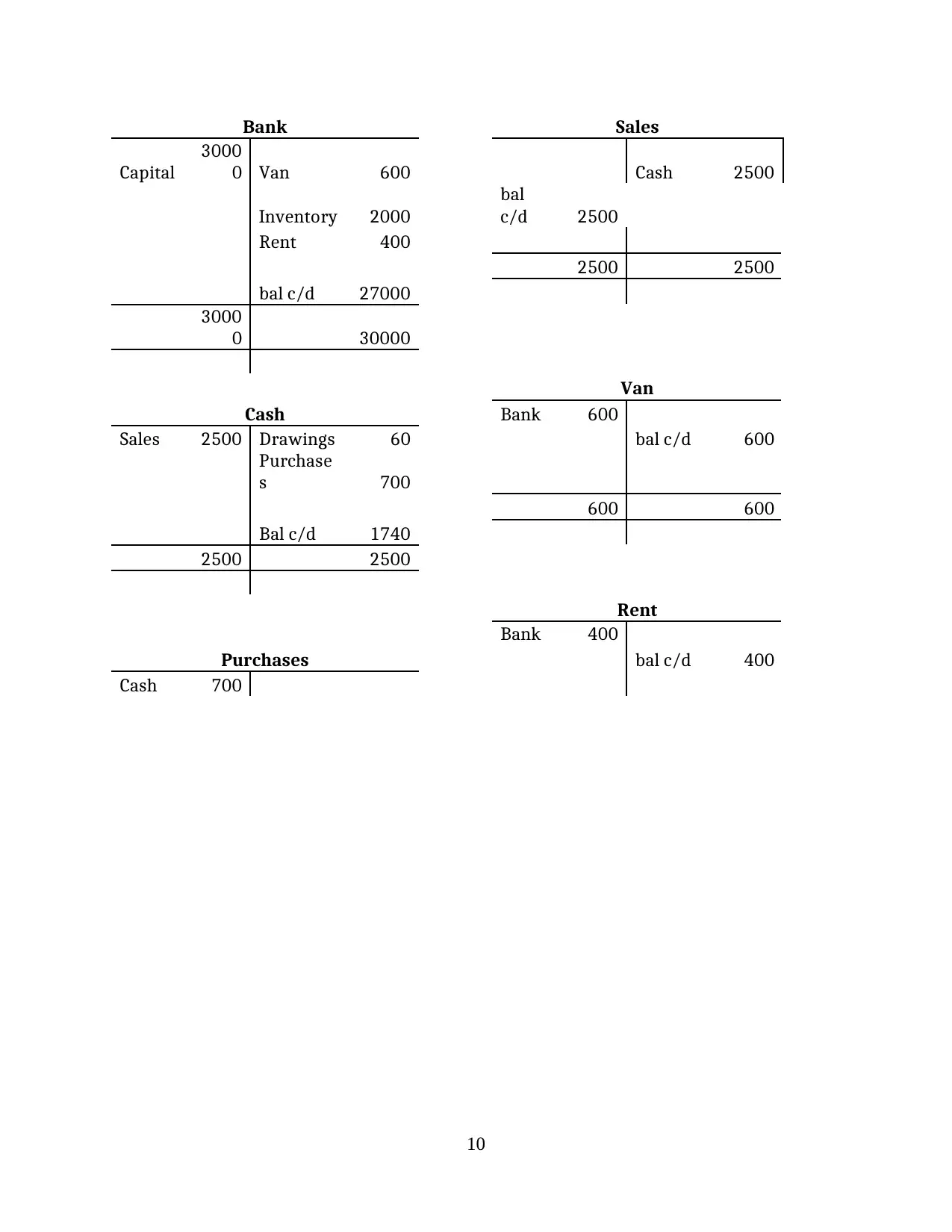
Bank Sales
Capital
3000
0 Van 600 Cash 2500
Inventory 2000
bal
c/d 2500
Rent 400
2500 2500
bal c/d 27000
3000
0 30000
Van
Cash Bank 600
Sales 2500 Drawings 60 bal c/d 600
Purchase
s 700
600 600
Bal c/d 1740
2500 2500
Rent
Bank 400
Purchases bal c/d 400
Cash 700
10
Capital
3000
0 Van 600 Cash 2500
Inventory 2000
bal
c/d 2500
Rent 400
2500 2500
bal c/d 27000
3000
0 30000
Van
Cash Bank 600
Sales 2500 Drawings 60 bal c/d 600
Purchase
s 700
600 600
Bal c/d 1740
2500 2500
Rent
Bank 400
Purchases bal c/d 400
Cash 700
10
You're viewing a preview
Unlock full access by subscribing today!
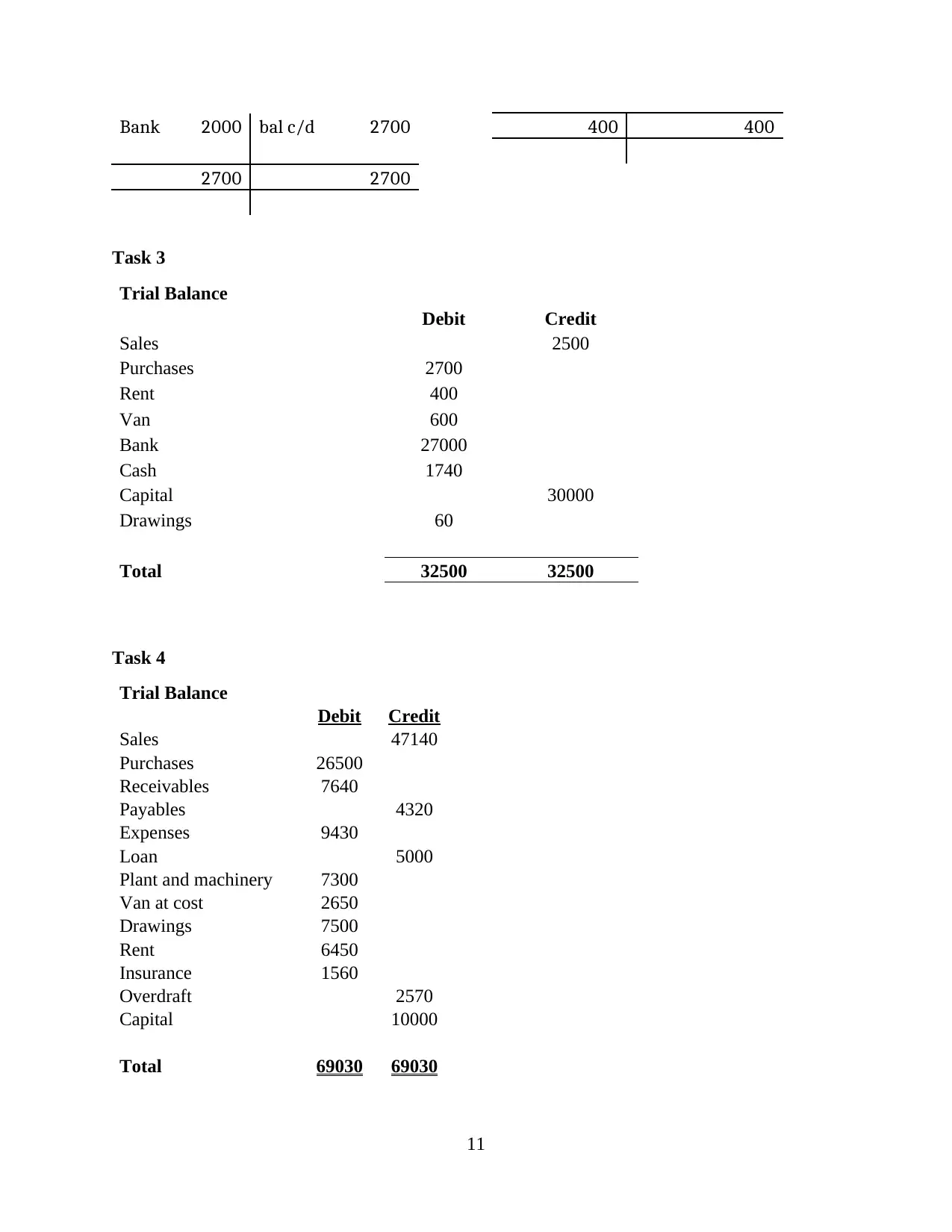
Bank 2000 bal c/d 2700 400 400
2700 2700
Task 3
Trial Balance
Debit Credit
Sales 2500
Purchases 2700
Rent 400
Van 600
Bank 27000
Cash 1740
Capital 30000
Drawings 60
Total 32500 32500
Task 4
Trial Balance
Debit Credit
Sales 47140
Purchases 26500
Receivables 7640
Payables 4320
Expenses 9430
Loan 5000
Plant and machinery 7300
Van at cost 2650
Drawings 7500
Rent 6450
Insurance 1560
Overdraft 2570
Capital 10000
Total 69030 69030
11
2700 2700
Task 3
Trial Balance
Debit Credit
Sales 2500
Purchases 2700
Rent 400
Van 600
Bank 27000
Cash 1740
Capital 30000
Drawings 60
Total 32500 32500
Task 4
Trial Balance
Debit Credit
Sales 47140
Purchases 26500
Receivables 7640
Payables 4320
Expenses 9430
Loan 5000
Plant and machinery 7300
Van at cost 2650
Drawings 7500
Rent 6450
Insurance 1560
Overdraft 2570
Capital 10000
Total 69030 69030
11
Paraphrase This Document
Need a fresh take? Get an instant paraphrase of this document with our AI Paraphraser
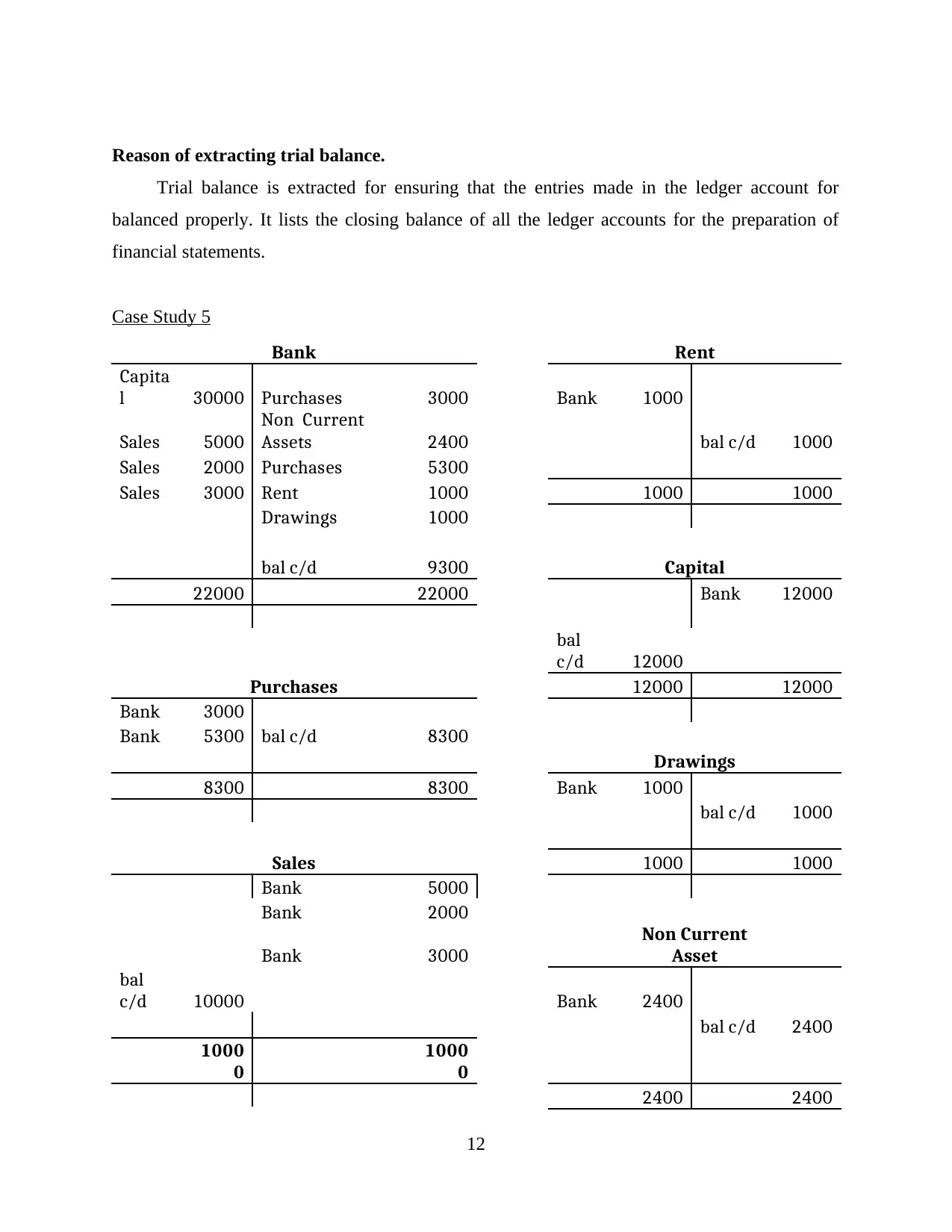
Reason of extracting trial balance.
Trial balance is extracted for ensuring that the entries made in the ledger account for
balanced properly. It lists the closing balance of all the ledger accounts for the preparation of
financial statements.
Case Study 5
Bank Rent
Capita
l 30000 Purchases 3000 Bank 1000
Sales 5000
Non Current
Assets 2400 bal c/d 1000
Sales 2000 Purchases 5300
Sales 3000 Rent 1000 1000 1000
Drawings 1000
bal c/d 9300 Capital
22000 22000 Bank 12000
bal
c/d 12000
Purchases 12000 12000
Bank 3000
Bank 5300 bal c/d 8300
Drawings
8300 8300 Bank 1000
bal c/d 1000
Sales 1000 1000
Bank 5000
Bank 2000
Bank 3000
Non Current
Asset
bal
c/d 10000 Bank 2400
bal c/d 2400
1000
0
1000
0
2400 2400
12
Trial balance is extracted for ensuring that the entries made in the ledger account for
balanced properly. It lists the closing balance of all the ledger accounts for the preparation of
financial statements.
Case Study 5
Bank Rent
Capita
l 30000 Purchases 3000 Bank 1000
Sales 5000
Non Current
Assets 2400 bal c/d 1000
Sales 2000 Purchases 5300
Sales 3000 Rent 1000 1000 1000
Drawings 1000
bal c/d 9300 Capital
22000 22000 Bank 12000
bal
c/d 12000
Purchases 12000 12000
Bank 3000
Bank 5300 bal c/d 8300
Drawings
8300 8300 Bank 1000
bal c/d 1000
Sales 1000 1000
Bank 5000
Bank 2000
Bank 3000
Non Current
Asset
bal
c/d 10000 Bank 2400
bal c/d 2400
1000
0
1000
0
2400 2400
12
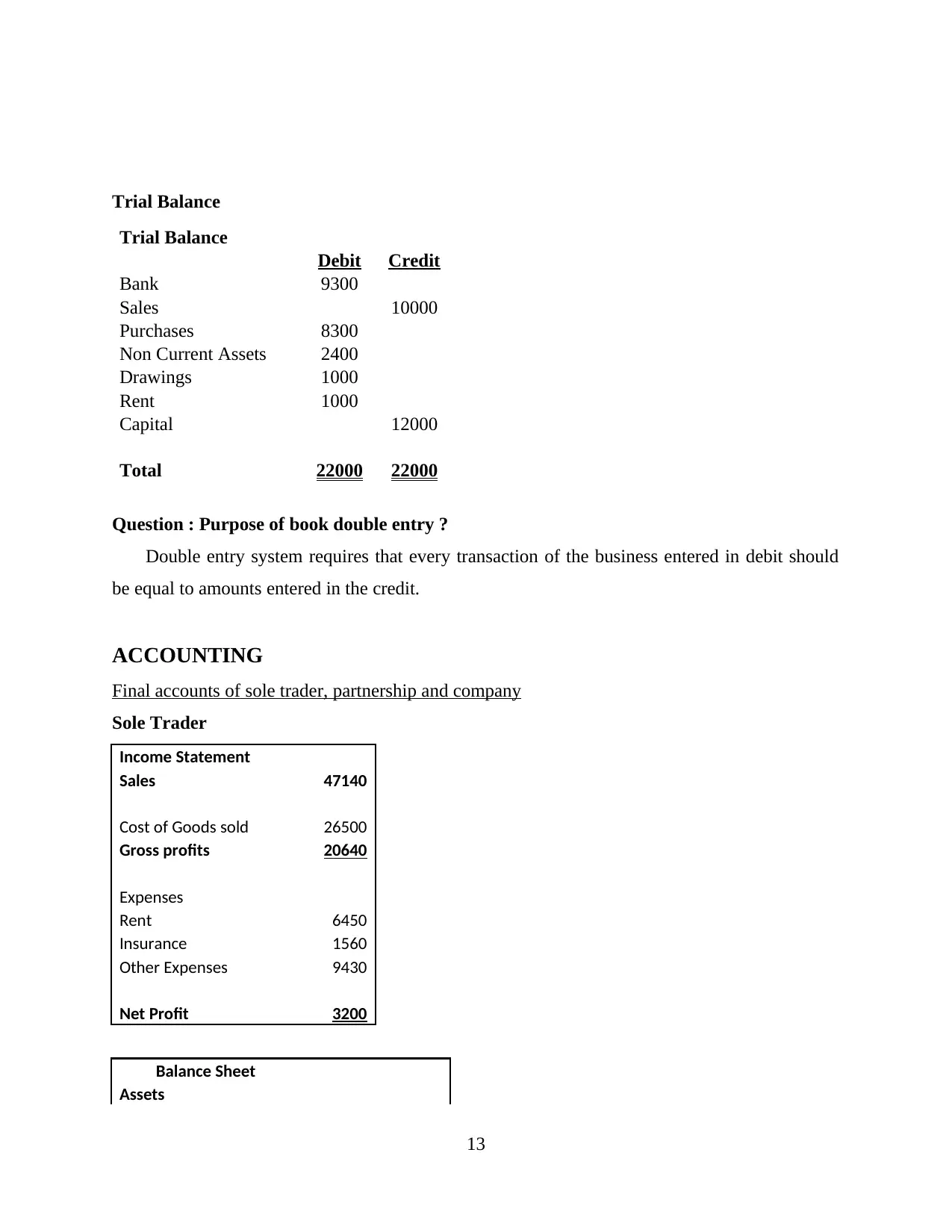
Trial Balance
Trial Balance
Debit Credit
Bank 9300
Sales 10000
Purchases 8300
Non Current Assets 2400
Drawings 1000
Rent 1000
Capital 12000
Total 22000 22000
Question : Purpose of book double entry ?
Double entry system requires that every transaction of the business entered in debit should
be equal to amounts entered in the credit.
ACCOUNTING
Final accounts of sole trader, partnership and company
Sole Trader
Income Statement
Sales 47140
Cost of Goods sold 26500
Gross profits 20640
Expenses
Rent 6450
Insurance 1560
Other Expenses 9430
Net Profit 3200
Balance Sheet
Assets
13
Trial Balance
Debit Credit
Bank 9300
Sales 10000
Purchases 8300
Non Current Assets 2400
Drawings 1000
Rent 1000
Capital 12000
Total 22000 22000
Question : Purpose of book double entry ?
Double entry system requires that every transaction of the business entered in debit should
be equal to amounts entered in the credit.
ACCOUNTING
Final accounts of sole trader, partnership and company
Sole Trader
Income Statement
Sales 47140
Cost of Goods sold 26500
Gross profits 20640
Expenses
Rent 6450
Insurance 1560
Other Expenses 9430
Net Profit 3200
Balance Sheet
Assets
13
You're viewing a preview
Unlock full access by subscribing today!
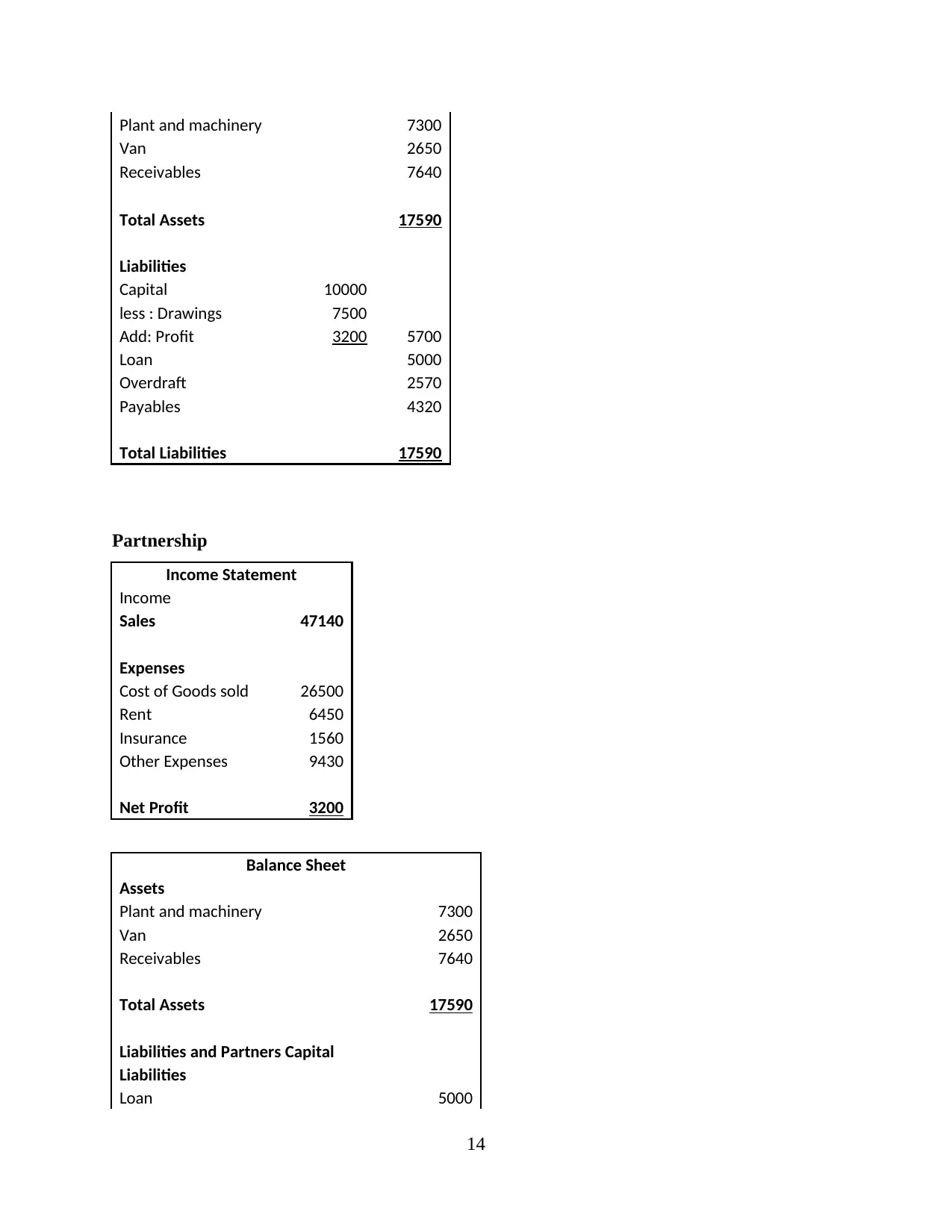
Plant and machinery 7300
Van 2650
Receivables 7640
Total Assets 17590
Liabilities
Capital 10000
less : Drawings 7500
Add: Profit 3200 5700
Loan 5000
Overdraft 2570
Payables 4320
Total Liabilities 17590
Partnership
Income Statement
Income
Sales 47140
Expenses
Cost of Goods sold 26500
Rent 6450
Insurance 1560
Other Expenses 9430
Net Profit 3200
Balance Sheet
Assets
Plant and machinery 7300
Van 2650
Receivables 7640
Total Assets 17590
Liabilities and Partners Capital
Liabilities
Loan 5000
14
Van 2650
Receivables 7640
Total Assets 17590
Liabilities
Capital 10000
less : Drawings 7500
Add: Profit 3200 5700
Loan 5000
Overdraft 2570
Payables 4320
Total Liabilities 17590
Partnership
Income Statement
Income
Sales 47140
Expenses
Cost of Goods sold 26500
Rent 6450
Insurance 1560
Other Expenses 9430
Net Profit 3200
Balance Sheet
Assets
Plant and machinery 7300
Van 2650
Receivables 7640
Total Assets 17590
Liabilities and Partners Capital
Liabilities
Loan 5000
14
Paraphrase This Document
Need a fresh take? Get an instant paraphrase of this document with our AI Paraphraser
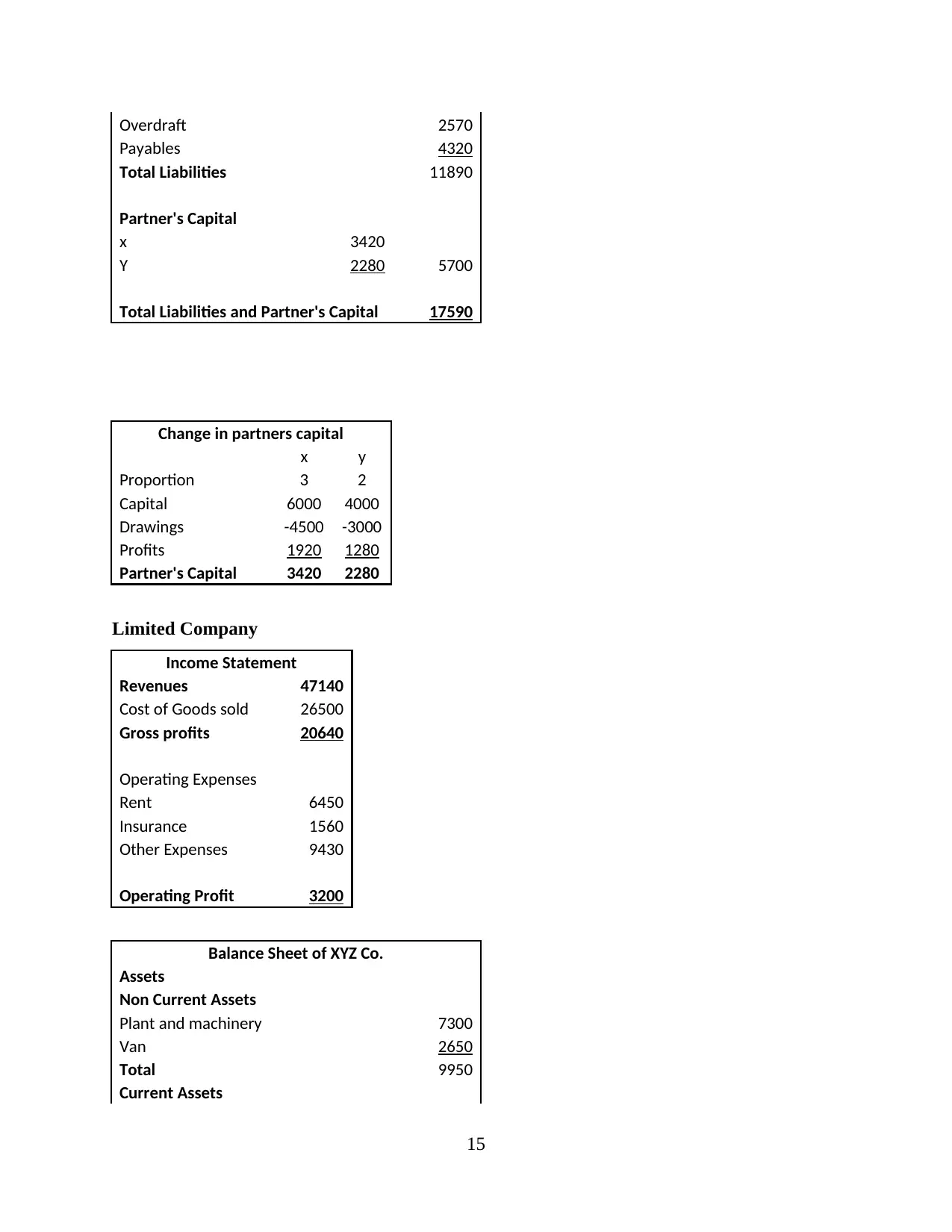
Overdraft 2570
Payables 4320
Total Liabilities 11890
Partner's Capital
x 3420
Y 2280 5700
Total Liabilities and Partner's Capital 17590
Change in partners capital
x y
Proportion 3 2
Capital 6000 4000
Drawings -4500 -3000
Profits 1920 1280
Partner's Capital 3420 2280
Limited Company
Income Statement
Revenues 47140
Cost of Goods sold 26500
Gross profits 20640
Operating Expenses
Rent 6450
Insurance 1560
Other Expenses 9430
Operating Profit 3200
Balance Sheet of XYZ Co.
Assets
Non Current Assets
Plant and machinery 7300
Van 2650
Total 9950
Current Assets
15
Payables 4320
Total Liabilities 11890
Partner's Capital
x 3420
Y 2280 5700
Total Liabilities and Partner's Capital 17590
Change in partners capital
x y
Proportion 3 2
Capital 6000 4000
Drawings -4500 -3000
Profits 1920 1280
Partner's Capital 3420 2280
Limited Company
Income Statement
Revenues 47140
Cost of Goods sold 26500
Gross profits 20640
Operating Expenses
Rent 6450
Insurance 1560
Other Expenses 9430
Operating Profit 3200
Balance Sheet of XYZ Co.
Assets
Non Current Assets
Plant and machinery 7300
Van 2650
Total 9950
Current Assets
15
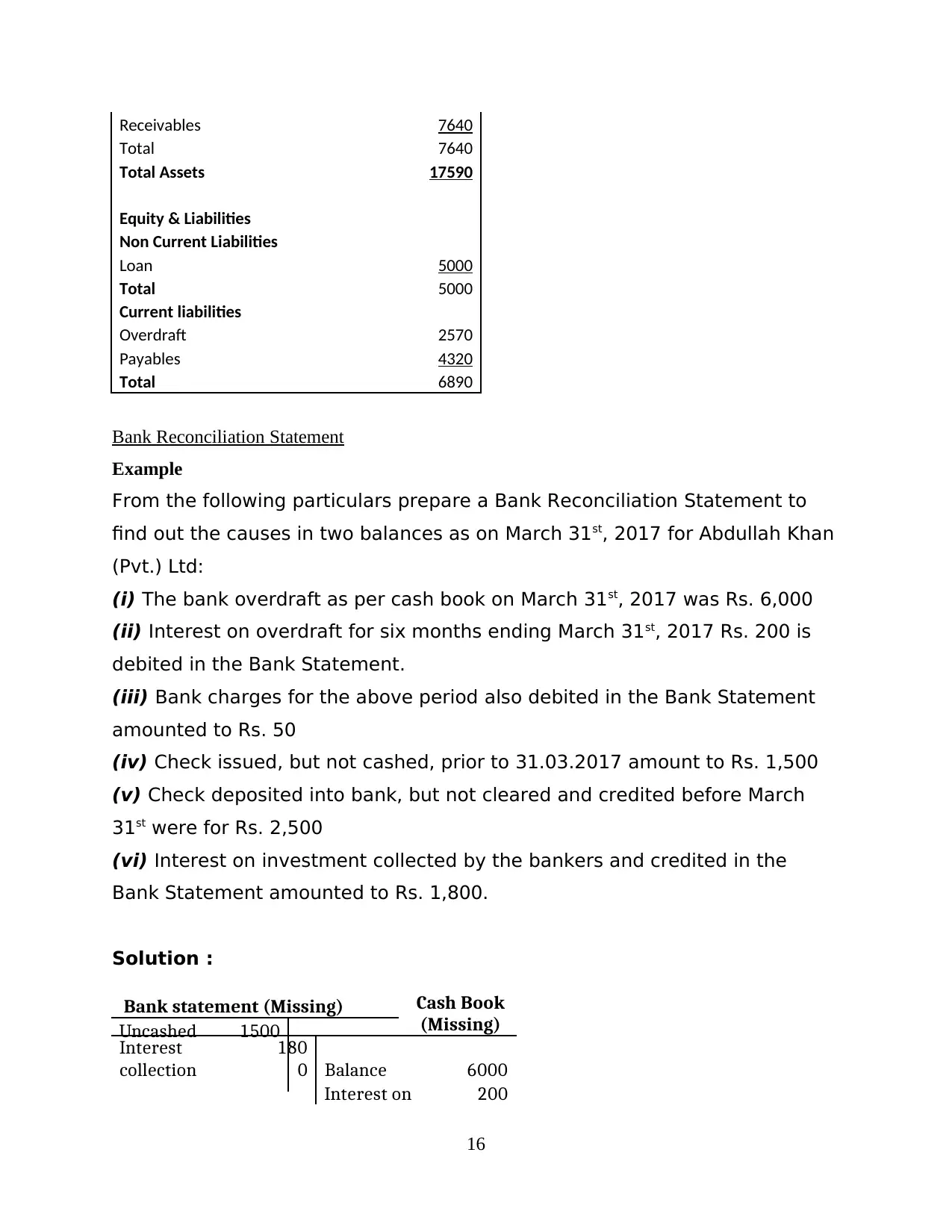
Receivables 7640
Total 7640
Total Assets 17590
Equity & Liabilities
Non Current Liabilities
Loan 5000
Total 5000
Current liabilities
Overdraft 2570
Payables 4320
Total 6890
Bank Reconciliation Statement
Example
From the following particulars prepare a Bank Reconciliation Statement to
find out the causes in two balances as on March 31st, 2017 for Abdullah Khan
(Pvt.) Ltd:
(i) The bank overdraft as per cash book on March 31st, 2017 was Rs. 6,000
(ii) Interest on overdraft for six months ending March 31st, 2017 Rs. 200 is
debited in the Bank Statement.
(iii) Bank charges for the above period also debited in the Bank Statement
amounted to Rs. 50
(iv) Check issued, but not cashed, prior to 31.03.2017 amount to Rs. 1,500
(v) Check deposited into bank, but not cleared and credited before March
31st were for Rs. 2,500
(vi) Interest on investment collected by the bankers and credited in the
Bank Statement amounted to Rs. 1,800.
Solution :
Cash Book
(Missing)
Interest
collection
180
0 Balance 6000
Interest on 200
16
Bank statement (Missing)
Uncashed 1500
Total 7640
Total Assets 17590
Equity & Liabilities
Non Current Liabilities
Loan 5000
Total 5000
Current liabilities
Overdraft 2570
Payables 4320
Total 6890
Bank Reconciliation Statement
Example
From the following particulars prepare a Bank Reconciliation Statement to
find out the causes in two balances as on March 31st, 2017 for Abdullah Khan
(Pvt.) Ltd:
(i) The bank overdraft as per cash book on March 31st, 2017 was Rs. 6,000
(ii) Interest on overdraft for six months ending March 31st, 2017 Rs. 200 is
debited in the Bank Statement.
(iii) Bank charges for the above period also debited in the Bank Statement
amounted to Rs. 50
(iv) Check issued, but not cashed, prior to 31.03.2017 amount to Rs. 1,500
(v) Check deposited into bank, but not cleared and credited before March
31st were for Rs. 2,500
(vi) Interest on investment collected by the bankers and credited in the
Bank Statement amounted to Rs. 1,800.
Solution :
Cash Book
(Missing)
Interest
collection
180
0 Balance 6000
Interest on 200
16
Bank statement (Missing)
Uncashed 1500
You're viewing a preview
Unlock full access by subscribing today!
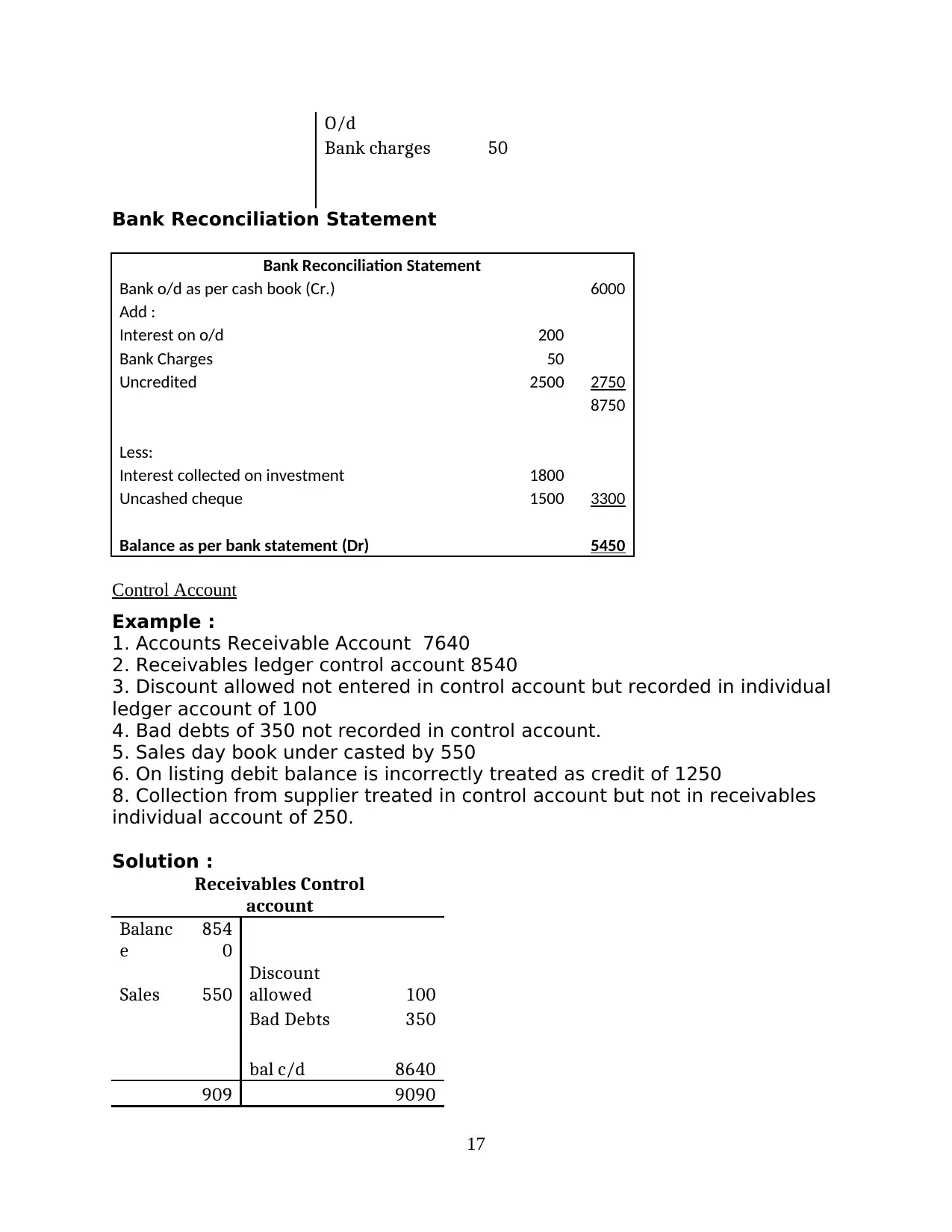
O/d
Bank charges 50
Bank Reconciliation Statement
Bank Reconciliation Statement
Bank o/d as per cash book (Cr.) 6000
Add :
Interest on o/d 200
Bank Charges 50
Uncredited 2500 2750
8750
Less:
Interest collected on investment 1800
Uncashed cheque 1500 3300
Balance as per bank statement (Dr) 5450
Control Account
Example :
1. Accounts Receivable Account 7640
2. Receivables ledger control account 8540
3. Discount allowed not entered in control account but recorded in individual
ledger account of 100
4. Bad debts of 350 not recorded in control account.
5. Sales day book under casted by 550
6. On listing debit balance is incorrectly treated as credit of 1250
8. Collection from supplier treated in control account but not in receivables
individual account of 250.
Solution :
Receivables Control
account
Balanc
e
854
0
Sales 550
Discount
allowed 100
Bad Debts 350
bal c/d 8640
909 9090
17
Bank charges 50
Bank Reconciliation Statement
Bank Reconciliation Statement
Bank o/d as per cash book (Cr.) 6000
Add :
Interest on o/d 200
Bank Charges 50
Uncredited 2500 2750
8750
Less:
Interest collected on investment 1800
Uncashed cheque 1500 3300
Balance as per bank statement (Dr) 5450
Control Account
Example :
1. Accounts Receivable Account 7640
2. Receivables ledger control account 8540
3. Discount allowed not entered in control account but recorded in individual
ledger account of 100
4. Bad debts of 350 not recorded in control account.
5. Sales day book under casted by 550
6. On listing debit balance is incorrectly treated as credit of 1250
8. Collection from supplier treated in control account but not in receivables
individual account of 250.
Solution :
Receivables Control
account
Balanc
e
854
0
Sales 550
Discount
allowed 100
Bad Debts 350
bal c/d 8640
909 9090
17
Paraphrase This Document
Need a fresh take? Get an instant paraphrase of this document with our AI Paraphraser
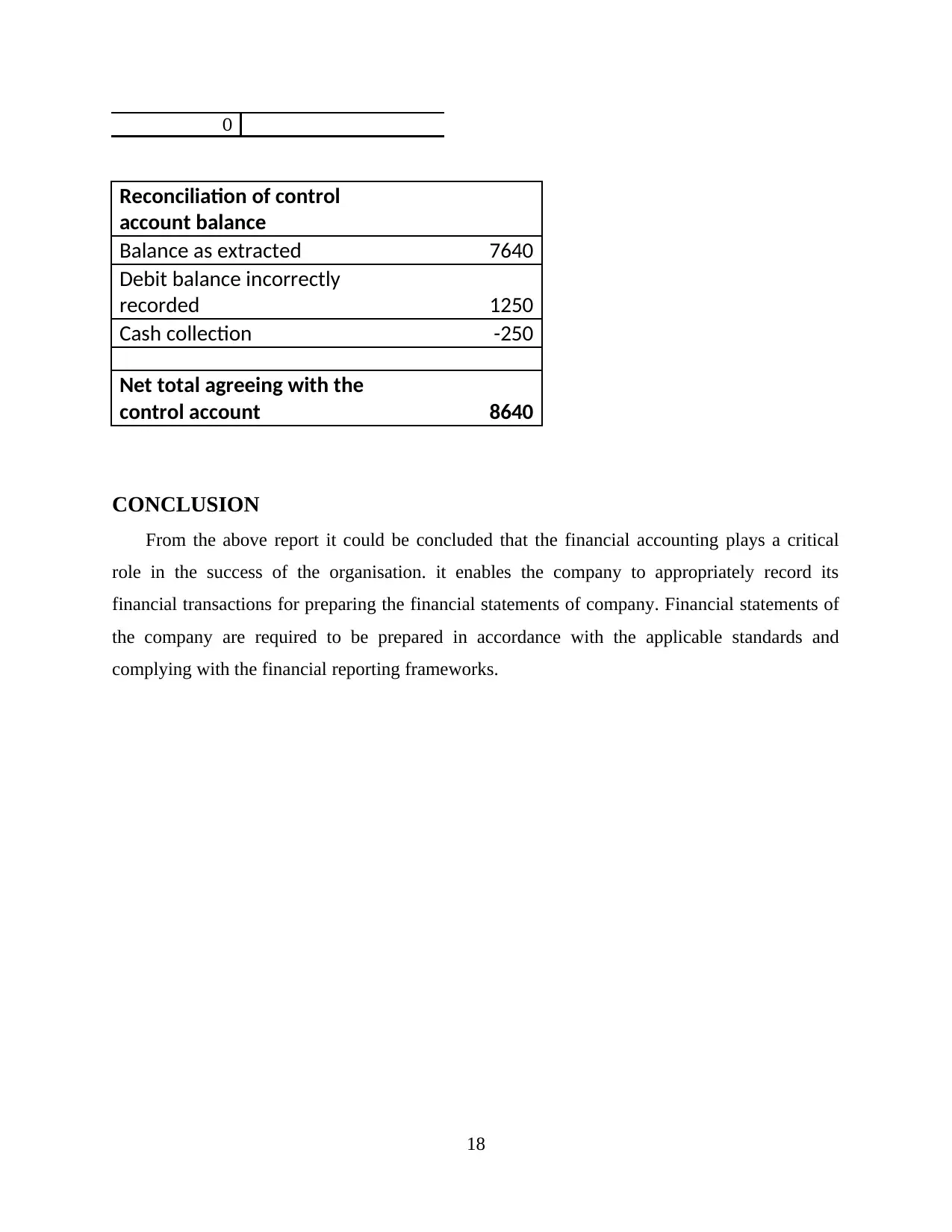
0
Reconciliation of control
account balance
Balance as extracted 7640
Debit balance incorrectly
recorded 1250
Cash collection -250
Net total agreeing with the
control account 8640
CONCLUSION
From the above report it could be concluded that the financial accounting plays a critical
role in the success of the organisation. it enables the company to appropriately record its
financial transactions for preparing the financial statements of company. Financial statements of
the company are required to be prepared in accordance with the applicable standards and
complying with the financial reporting frameworks.
18
Reconciliation of control
account balance
Balance as extracted 7640
Debit balance incorrectly
recorded 1250
Cash collection -250
Net total agreeing with the
control account 8640
CONCLUSION
From the above report it could be concluded that the financial accounting plays a critical
role in the success of the organisation. it enables the company to appropriately record its
financial transactions for preparing the financial statements of company. Financial statements of
the company are required to be prepared in accordance with the applicable standards and
complying with the financial reporting frameworks.
18
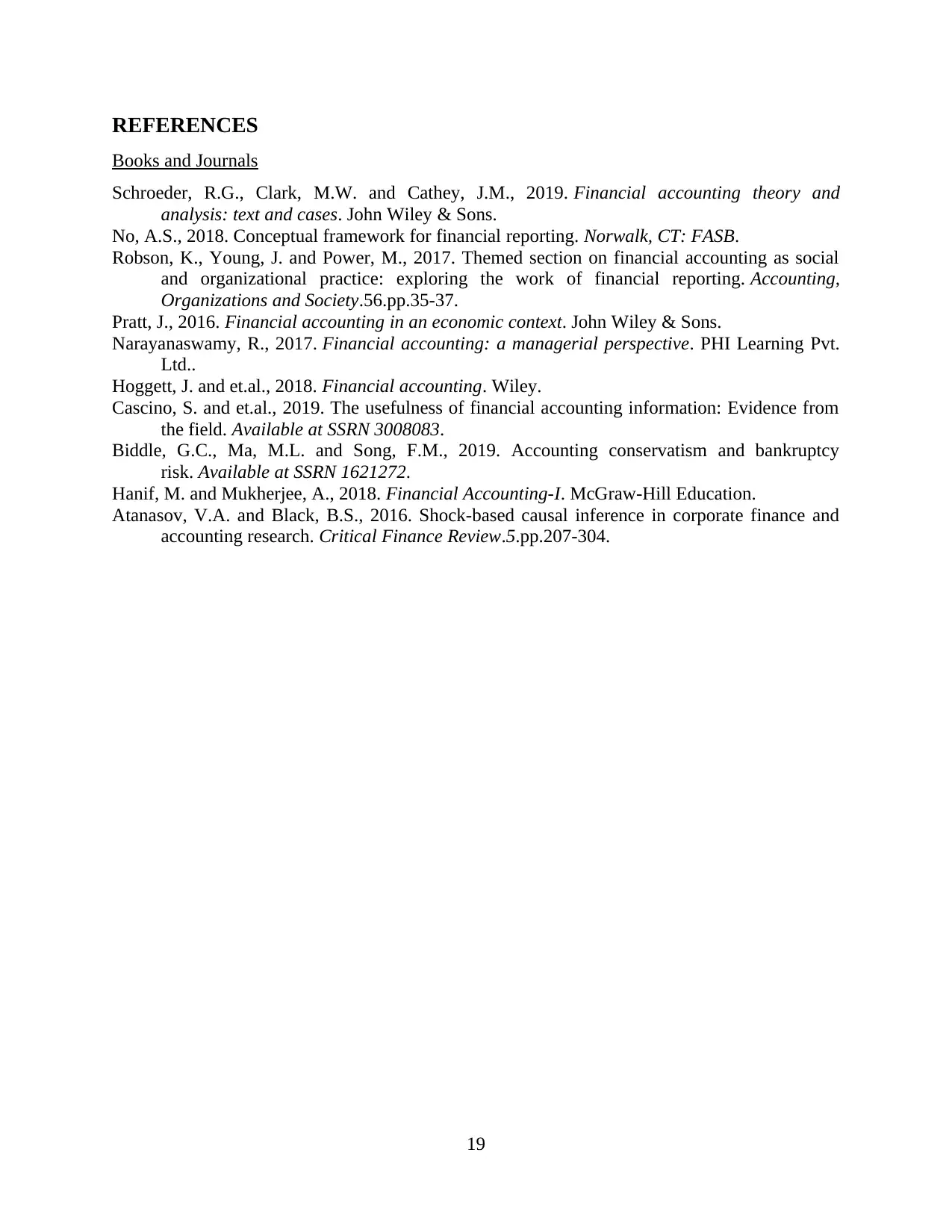
REFERENCES
Books and Journals
Schroeder, R.G., Clark, M.W. and Cathey, J.M., 2019. Financial accounting theory and
analysis: text and cases. John Wiley & Sons.
No, A.S., 2018. Conceptual framework for financial reporting. Norwalk, CT: FASB.
Robson, K., Young, J. and Power, M., 2017. Themed section on financial accounting as social
and organizational practice: exploring the work of financial reporting. Accounting,
Organizations and Society.56.pp.35-37.
Pratt, J., 2016. Financial accounting in an economic context. John Wiley & Sons.
Narayanaswamy, R., 2017. Financial accounting: a managerial perspective. PHI Learning Pvt.
Ltd..
Hoggett, J. and et.al., 2018. Financial accounting. Wiley.
Cascino, S. and et.al., 2019. The usefulness of financial accounting information: Evidence from
the field. Available at SSRN 3008083.
Biddle, G.C., Ma, M.L. and Song, F.M., 2019. Accounting conservatism and bankruptcy
risk. Available at SSRN 1621272.
Hanif, M. and Mukherjee, A., 2018. Financial Accounting-I. McGraw-Hill Education.
Atanasov, V.A. and Black, B.S., 2016. Shock-based causal inference in corporate finance and
accounting research. Critical Finance Review.5.pp.207-304.
19
Books and Journals
Schroeder, R.G., Clark, M.W. and Cathey, J.M., 2019. Financial accounting theory and
analysis: text and cases. John Wiley & Sons.
No, A.S., 2018. Conceptual framework for financial reporting. Norwalk, CT: FASB.
Robson, K., Young, J. and Power, M., 2017. Themed section on financial accounting as social
and organizational practice: exploring the work of financial reporting. Accounting,
Organizations and Society.56.pp.35-37.
Pratt, J., 2016. Financial accounting in an economic context. John Wiley & Sons.
Narayanaswamy, R., 2017. Financial accounting: a managerial perspective. PHI Learning Pvt.
Ltd..
Hoggett, J. and et.al., 2018. Financial accounting. Wiley.
Cascino, S. and et.al., 2019. The usefulness of financial accounting information: Evidence from
the field. Available at SSRN 3008083.
Biddle, G.C., Ma, M.L. and Song, F.M., 2019. Accounting conservatism and bankruptcy
risk. Available at SSRN 1621272.
Hanif, M. and Mukherjee, A., 2018. Financial Accounting-I. McGraw-Hill Education.
Atanasov, V.A. and Black, B.S., 2016. Shock-based causal inference in corporate finance and
accounting research. Critical Finance Review.5.pp.207-304.
19
You're viewing a preview
Unlock full access by subscribing today!
1 out of 21
Related Documents
Your All-in-One AI-Powered Toolkit for Academic Success.
+13062052269
info@desklib.com
Available 24*7 on WhatsApp / Email
![[object Object]](/_next/static/media/star-bottom.7253800d.svg)
Unlock your academic potential
© 2024 | Zucol Services PVT LTD | All rights reserved.





